The post How to Migrate to Shopify: A Step-by-Step Guide for eCommerce Brands appeared first on scandiweb.
]]>Shopify provides a stable foundation for brands seeking a more manageable and reliable tech stack, as well as a storefront that’s easy to maintain over time. Many teams also use the migration as an opportunity to update outdated data and close gaps created by years of patches and workarounds.
The move to Shopify works best with a structured approach and a realistic understanding of what needs to be rebuilt, imported, or reconfigured.
This guide breaks down the Shopify migration process into clear phases, starting with an assessment of your current setup, all the way to a live, tested Shopify store. If you’re preparing for a move to Shopify, this walkthrough will help you plan ahead and build a setup that supports steady growth from day one.
Common challenges before and after migration
Most teams move to Shopify expecting things to get easier, with fewer bugs, fewer delays, and more flexibility. And in many cases, that’s exactly what happens. But for brands with complex operations or legacy systems, the transition can expose deeper issues and sometimes create new ones if not managed carefully.
These are some of the most common challenges we’ve seen before and after replatforming:
Disconnected systems
Data doesn’t flow cleanly between tools. ERPs, CRMs, PIMs, and OMSs all need to be connected with care. Without the right architecture, syncing issues and data silos continue even after the migration.
Duplicated stores for international markets
Shopify is often set up as one store per market, which leads to duplicated catalogs and separate promotions that require more manual work across regions. Without a proper plan, complexity increases rather than decreases.
Heavy reliance on apps
Quick fixes often come in the form of third-party apps. Over time, this can create potential issues when one app fails or conflicts with another, compromising the entire flow.
Checkout limitations
Shopify offers limited flexibility for custom flows – checkout adjustments tied to region, pricing logic, or customer type can be challenging to implement natively.
SEO drops
If redirects, metadata, structure, and other tech SEO essentials aren’t handled properly, a migration to Shopify can lead to traffic losses. And recovery takes time, especially if the site had strong organic performance before migration.
No single source of truth
Even after migrating, many brands still struggle with fragmented data. Customer records don’t update in real-time, and analytics fail to reflect the complete picture. Without proper integration planning, the migration only moves the problem to a new platform.
Next, let’s walk through the Shopify migration process step by step.
Step 1: Audit your current platform
Before planning a move to Shopify, take a close look at your existing setup. A technical audit should go beyond surface-level issues. Many platforms evolve through quick fixes and ongoing adjustments, resulting in unpredictable behavior and a setup that’s difficult to manage. Reviewing how your store currently functions can reveal which parts of the system need to be replaced and which ones still serve their purpose.
Start by mapping out:
- Where your data lives (product, inventory, customer, order)
- Which tools are connected and how well they sync
- How promotions, checkout flows, or product bundles are currently handled
- Any third-party apps that feel essential but are adding complexity or cost
Next, look at content and UX:
- Are product pages consistent and easy to update?
- Does the mobile experience reflect your brand?
- Is it clear where the technical limitations are slowing down marketing or merchandising?
At this stage, it’s useful to ask: if your current store were wiped tomorrow, what would you rebuild the same way? And what would you change?
Step 2: Plan your Shopify setup
Once you understand how your current store operates, the next step is creating the foundation of your new Shopify environment. Decisions made here influence your data structure, daily workflows, performance, and the level of flexibility you’ll have long term.
Begin with the Shopify plan that best suits your needs. Stores with extensive catalogs, complex rules, or multiple markets often benefit from Shopify Plus due to its expanded limits and access to advanced features. Smaller setups can run smoothly on standard Shopify. The goal is to choose a plan that supports future growth without requiring major restructuring later.
Next, define the technical layout of your store. Some operate from a single Shopify store and manage regions through Shopify Markets. Others maintain separate stores for different countries or business units. It depends on pricing rules, tax logic, language requirements, fulfillment locations, and operational ownership inside the company.
This stage is also the time to outline integrations. ERPs, PIMs, OMSs, CRM platforms, and marketing tools all need clear data paths. If your current stack contains fragile connectors or outdated plugins, note these as items to rebuild or redesign during the migration. A dependable integration plan helps avoid issues that often appear after launch, like delayed stock updates, inconsistent product data, or incomplete customer profiles.
In parallel, prepare how teams will work inside Shopify. Roles, permissions, collaborator access, and staging environments should be arranged early, creating a controlled setup and a stable base.
Step 3: Clean and export your data
Migration also exposes the quality of the data you’ve been working with and how much of it needs improvement.
Start with your product catalog. Check for duplicate SKUs, inconsistent naming, outdated items, or mismatched attributes. If different teams have been adding products over time, structure and formatting may vary across collections. Fixing this now will prevent downstream errors during import and create a better shopping experience once live.
Review your customer database next. Identify test records, unsubscribed contacts, and incomplete profiles. Decide which segments are still active and worth migrating. Cleaning customer data before export also improves targeting accuracy for marketing flows once Shopify is live.
For orders, confirm which records are needed for historical reporting. Some brands choose to migrate all order history, while others only keep recent data. Shopify allows historical orders to be imported for reference, but they won’t behave like native orders – so plan how you want to access and report on past activity.
Most platforms support CSV exports. If your setup is more custom, API access or direct database extraction may be required. Either way, the export phase is an opportunity to restructure and clarify how data will be stored within Shopify.
scandiweb’s team often runs custom cleanup workflows at this stage. For example, during one migration, thousands of SKUs needed to be standardized before import, not just for accuracy, but to ensure compatibility with advanced search and filtering logic later on. Well-prepared data helps the rest of the migration proceed more efficiently. It also reduces support tickets after launch, since product visibility, pricing, and customer records are already in order.
Step 4: Import data into Shopify
Once your product, customer, and order data have been reviewed and cleaned, you can begin importing it into Shopify. This step often happens in phases, starting with a controlled test, followed by a broader import once everything checks out.
Product imports
Shopify supports CSV uploads for standard product fields such as titles, descriptions, pricing, inventory, and variants. For more complex catalogs, additional data like metafields, vendor references, or grouped items may need to be imported using Shopify’s Admin API or other tools. Some projects also rely on custom scripts for better control.
After the initial upload, check the results for errors. Missing images, broken variant logic, or inconsistent pricing structures are common issues. Bulk editing tools in Shopify can help resolve minor issues quickly, but more significant discrepancies may require rework at the source.
Collections and categories
In Shopify, collections can be either manual (where the team selects products) or automated (where products are included based on tags, price, or other conditions). Decide early which model fits best. Automated collections save time for larger catalogs but require consistent product data. Manual collections give more flexibility for merchandising, campaigns, or curated selections.
If your previous platform used custom category logic or allowed deep nesting, prepare for some adjustments. Shopify structures categories differently, and large taxonomies often need simplification. It’s also important to plan how URLs for collections will be handled, especially for SEO continuity.
Customer and order imports
Customer data can be imported via CSV, but certain details will not be carried over, including passwords and saved payment methods. Expect to send account activation emails once the store is live. This part of the migration should be timed carefully to avoid confusion or support overload.
Historical orders can also be imported for reporting purposes. They won’t behave like new Shopify orders (e.g., no refunds or fulfillment actions), but they help preserve account context and lifetime value tracking.
The goal here is stability, ensuring that the data appears in the right place and functions reliably for customers and your team.
Step 5: Configure payments, shipping, and tax
Once your store structure and data are in place, it’s time to set up the core functions that power transactions and fulfillment. Payment gateways, shipping rules, and tax settings each carry operational weight, and gaps in this step often show up as customer complaints or failed orders that translate into lost revenue.
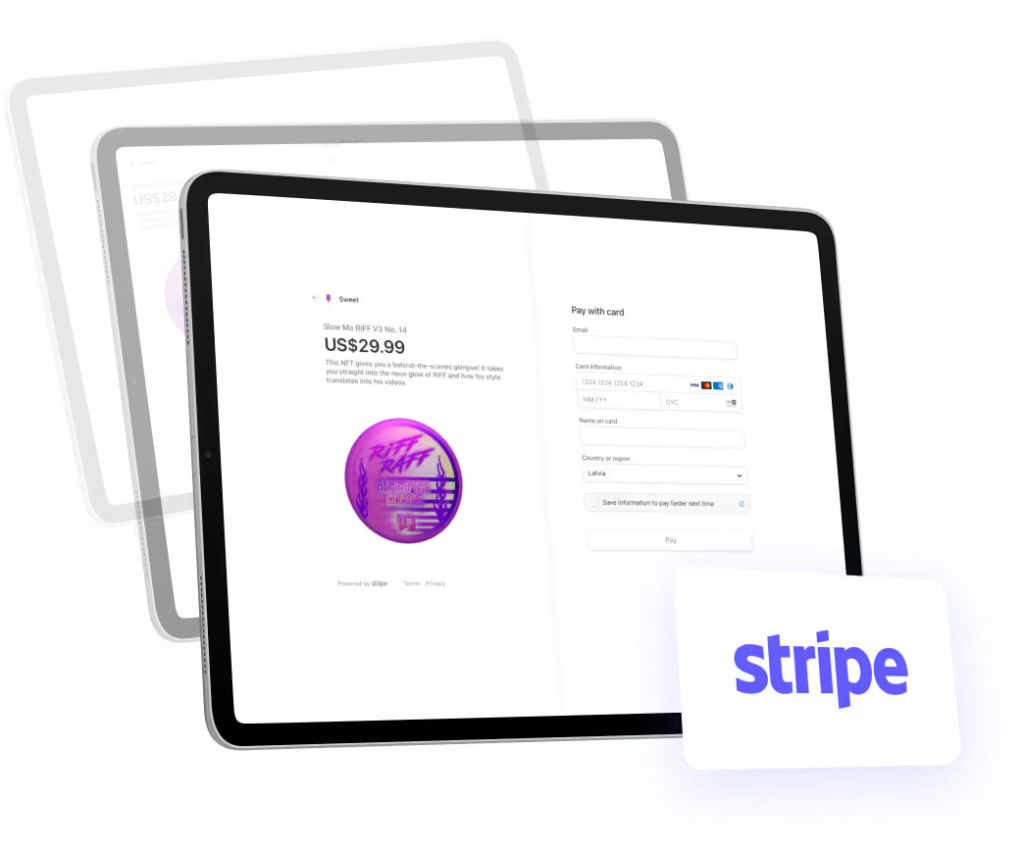
Payment methods
Start by enabling your preferred payment providers. If you’re eligible for Shopify Payments, it’s typically the most common option. It covers major credit cards and wallets like Apple Pay or Google Pay, and gives access to features like fraud protection, chargeback handling, and consolidated reporting.
If your store sells internationally, activate local methods commonly used in your target regions. Payment preferences vary widely by market, and improving checkout familiarity often improves conversion rates. Shopify supports location-based logic to display relevant payment methods to each shopper.
Any previously saved payment methods from your old platform will not carry over, due to compliance rules. Customers will need to re-enter their details on their next purchase, so plan communications around this to prevent confusion.
Shipping setup
Shipping rules in Shopify are managed through zones and profiles. Define where you ship and which methods apply to each region:
- Flat rates
- Real-time carrier rates
- Local delivery
- Free shipping thresholds.
If you use a 3PL, warehouse network, or dropshipping setup, connect those providers early. Make sure they’re fully integrated before launch to avoid fulfillment delays. Shipping apps or native Shopify integrations can support this, depending on your logistics setup. Test different scenarios – local orders, international deliveries, split shipments – to confirm that shipping charges and workflows are accurate.
Taxes and compliance
Shopify can calculate taxes automatically based on store location and customer address. In more complex regions, or when selling across borders, additional configuration may be needed.
Enable Shopify Markets if you plan to support multiple currencies, duties, or tax-inclusive pricing. You can also integrate third-party tools for more granular control, especially in jurisdictions with changing tax laws. Remember – Misconfigured tax settings can trigger penalties or create liabilities post-launch.
Quick test checklist
Before moving forward, confirm that:
✓ All required payment methods are active and display correctly by region
✓ You’ve tested real transactions with at least two payment types (e.g., credit card + local method)
✓ Shipping rates calculate correctly for key zones
✓ Fulfillment logic works across split shipments or multi-warehouse setups
✓ Taxes are calculated correctly based on customer location and product type
✓ Checkout totals reflect the correct currency, tax, and shipping format
✓ Manual and automated order confirmations include all expected details.
Step 6: Protect SEO during migration
Organic traffic is one of the most valuable assets your store has, and also one of the easiest to lose during a migration. Platform changes often shift how pages are structured, how content is displayed, and how URLs are generated. Without a clear SEO strategy, visibility can drop, and recovery can take months.
- Audit your current site to identify which pages bring in the most traffic, generate conversions, or support important keywords. These high-value URLs should be preserved or mapped as closely as possible in your Shopify structure.
Shopify uses a fixed URL format, so some changes will be unavoidable. For example, product pages will always follow the /products/ path. That doesn’t mean performance has to drop, but it does mean you’ll need a detailed redirect plan.
- Create a complete list of old URLs and their new equivalents. Use 301 redirects to guide users and search engines to the right content. Shopify’s built-in redirect manager works for this, and bulk uploads are supported via CSV.
- Migrations also affect metadata, structured data, and internal linking. If your original store used custom logic for canonical tags, breadcrumbs, or product schema, plan how these will be handled in Shopify. You may need theme updates or app support to recreate the same structure.
- Before going live, submit your new XML sitemap to Google Search Console. Use tools like Screaming Frog or Ahrefs to crawl your Shopify site, catch errors, and confirm that key content is indexed and discoverable. Monitor performance closely for the first few weeks after launch, especially impressions and keyword positions for your most important pages.
Step 7: Design your Shopify store

A redesign during migration offers the chance to improve how products are found, how trust is built, and how easily customers complete a purchase within a framework that supports long-term performance and day-to-day usability.
Shopify themes offer flexible sections, speed improvements, and greater control without heavy developer input. Some brands adapt a premium theme to meet their goals, but you can work with partners to build something entirely custom. If you’re looking for performance and scalability without starting from scratch, options like our Satoshi theme for Shopify can provide a fast, UX-driven foundation that’s easy to adapt and extend.
For stores migrating from legacy platforms, there’s often technical debt embedded in the frontend, manifesting as inconsistent layouts, overlapping styles, and custom scripts that are difficult to update. This is a good moment to reset. Focus on clarity and plan design systems that scale with your catalog and feel consistent from homepage to checkout.
Banners, content blocks, promotional areas, and landing pages should be editable without developer support. If you’re using Shopify Plus, additional options like Shopify Scripts or custom checkout styling may be introduced at this stage.
Where possible, carry forward high-performing layouts from the previous store, especially on product and collection pages. Shopify allows enough flexibility to preserve familiar structures while still upgrading the experience, which helps maintain conversion performance and keeps the transition smooth for returning customers.
Page speed, mobile UX, and navigation logic all contribute to how the site performs post-launch. Keep images lightweight, test on real devices, and avoid unnecessary app installations or features that slow down the experience.
Step 8: Integrate third-party tools & systems
A migration is rarely about the storefront alone. eCommerce operations rely on a network of systems, including ERPs, PIMs, CRMs, marketing tools, analytics platforms, and fulfillment partners.
To account for these integrations, list out every system currently connected to your platform, including internal tools and third-party apps. For each, define what the integration needs to do: push product data, pull order updates, sync customer records, or support segmentation and automation.
From there, map how these systems will interact with Shopify. While some connections can be rebuilt using Shopify’s native APIs or public apps, others may need middleware or custom connectors, especially if your current setup involves multiple sources of truth or large product catalogs.
Common integration points include:
- ERP
- PIM
- CRM/ESP
- OMS/WMS
- CDP/analytics.
Think beyond day one. Integrations often break because they’re built without version control or clear documentation. And definitely consider app usage. Some migrations copy over every tool from the old platform without re-evaluating their value. Use this moment to reduce reliance on apps that introduce overhead or performance issues. Shopify’s ecosystem offers thousands of tools, but not all are worth keeping.
Step 9: Test before launch
This phase is about ensuring the entire system functions properly under real-world conditions.
Start with a soft launch environment. Shopify allows you to preview the store under password protection while running tests in a near-live setting. This gives your team space to validate functionality without exposing the site to customers before it’s ready.
Test core user flows:
- Browsing products and filtering by attributes
- Adding items to the cart
- Proceeding to checkout
- Using discounts
- Using gift cards
- Creating and managing customer accounts
- Completing an order with different payment methods.
Then, test operational flows:
- Order receipt and confirmation emails
- Admin order tracking and status updates
- Fulfillment syncing with warehouses
- Product updates from your ERP or PIM
- Marketing integrations – email triggers, CRM sync, analytics tracking.
Browser and device testing should also be done at this stage. Confirm that the experience is consistent across mobile, tablet, and desktop devices, with a focus on core actions such as search and checkout. Shopify themes are responsive by default, but customizations or third-party apps can introduce display issues in specific environments.
If you’re running multiple stores or markets, test behavior across regions. Pricing, currency, tax display, language, and payment options should all reflect the correct logic for each user location. Shopify Markets can handle this well, provided they are configured and verified correctly.
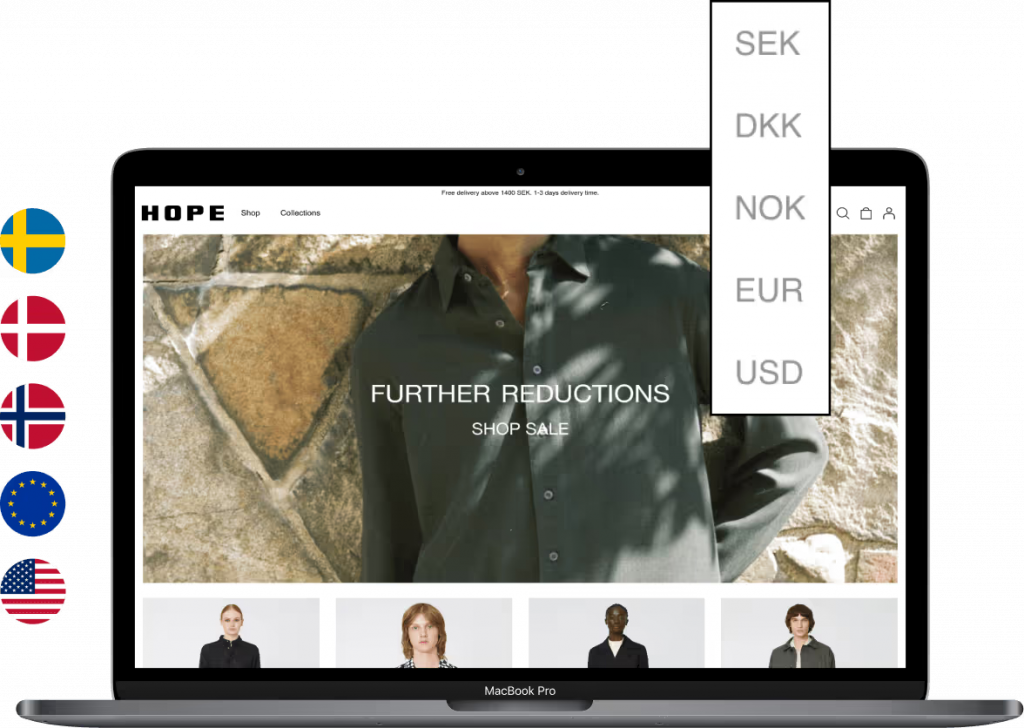
Real orders should be placed internally to validate the full purchase-to-fulfillment cycle. Test edge cases too, such as partial refunds, canceled orders, or out-of-stock items.
Once the basics are confirmed, focus on monitoring. Use tools like Google Tag Manager, Meta Pixel, or GA4 to track how behavior is recorded across the site. Migrations can disrupt analytics setups, especially if tag placement or page templates have changed. A well-tested store can significantly reduce launch-day stress. It also reduces the number of early support tickets from customers encountering avoidable issues.
Step 10: Launch and monitor your Shopify store
Congrats if you’ve made it to this step in your migration timeline – it’s time to go live! But what happens after launch matters just as much as what leads up to it.
Essentials to go through:
- Remove storefront password protection
- Point your domain to the new Shopify store
- Check that all redirects are active and resolving correctly
- Submit your updated XML sitemap in Google Search Console
- Monitor traffic, behavior, and error reports from the first visit onward.
Once live, confirm that key journeys still perform as expected. Add-to-cart, checkout, payment, integrations, and customer account flows should be tested again in the live environment.
After launch, monitor:
- Page speed and uptime
- Cart and checkout abandonment
- Product visibility and search functionality
- Channel-specific tracking (Meta, Google Ads, TikTok, Klaviyo, etc.)
- Sales trends across devices, countries, and segments.
The goal of every Shopify migration launch is the same: a stable, accurate, and responsive store that customers can trust.
Case study: Magento 1 to Shopify migration for J.R. Dunn
J.R. Dunn, a leading U.S. luxury jeweler and authorized Rolex retailer, partnered with scandiweb to move from Magento 1 to Shopify, modernizing their digital store while preserving the depth and elegance of their brand experience.
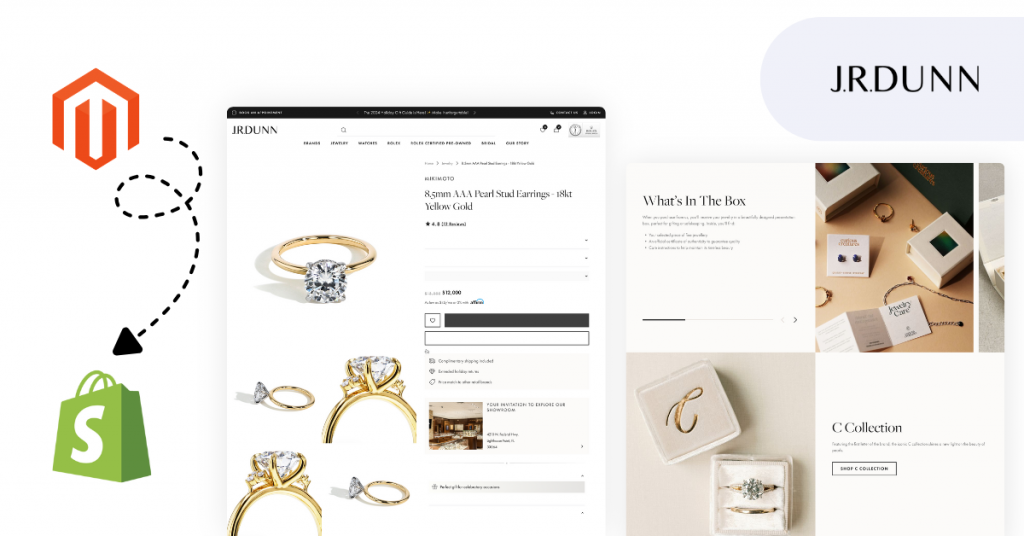
The project involved migrating a highly customized catalog of over 150,000 diamonds, with complex filtering, multi-vendor feeds, and legacy data structures. Out-of-the-box tools couldn’t provide the level of control required, so we built a custom diamond management app to import product data from five vendors, handle live pricing and availability, and integrate directly with Shopify Admin for product management and reservations.
To support advanced product discovery, we also integrated Fast Simon for smart faceted filtering and instant recommendations across a high-SKU catalog. We developed custom storefront features, including a native Ring Builder tool, without third-party dependencies to ensure long-term performance and stability. For design, we used the Satoshi theme, tailored for a luxury presentation.
Results
- 150,000+ diamonds imported via custom app
- 72,000 historical orders and 68,000 customers migrated
- 1,000+ categories and 25,000+ products restructured
- Full SEO migration with a 100 SEO score at launch
- Future-ready architecture for ERP and automation extensions.
Read the full J.R. Dunn Shopify migration case study here.
Shopify migration checklist
Let’s put it all together – use this checklist to track progress across the full migration process!
Platform audit
✓ Identify pain points, limitations, and legacy issues
✓ Map all integrations and third-party tools
✓ Review catalog structure, content quality, and data accuracy
✓ Evaluate technical performance, site speed, and UX consistency
Shopify setup
✓ Select the Shopify plan
✓ Configure account settings, staging access, and roles
✓ Plan architecture: single vs multi-store, Shopify Markets
✓ Outline integration paths for ERP, PIM, OMS, CRM, and ESP
Data cleaning & export
✓ Clean product data, SKUs, images, and variants
✓ De-duplicate and segment customer records
✓ Export historical orders if required
✓ Prepare clean CSVs or API feeds for import
Data import & catalog build
✓ Import products, collections, and content pages
✓ Set up metafields, filters, and search tools
✓ Migrate customer profiles and configure account invite flow
✓ Import historical orders for reference/reporting
Payments, shipping, tax
✓ Enable Shopify Payments and/or third-party gateways
✓ Configure domestic and international shipping rules
✓ Set up tax calculations for all regions
✓ Test payment flows and shipping scenarios
SEO & redirects
✓ Audit top URLs, keywords, and content
✓ Map and upload 301 redirects
✓ Migrate metadata and structured data
✓ Submit sitemap and monitor indexing
Design & UX
✓ Choose and customize theme
✓ Align page templates with performance and brand goals
✓ Optimize for mobile, accessibility, and load speed
✓ Enable editable content zones for marketing flexibility
Apps & integrations
✓ Review and rebuild all essential integrations
✓ Limit app usage to high-value tools
✓ Test data flow across all systems
✓ Document error handling and sync logic
Testing
✓ Run full QA across customer and admin flows
✓ Test tracking and analytics setup
✓ Validate behavior across regions, currencies, and devices
✓ Place real orders using different methods
Launch & post-launch
✓ Remove password protection and go live
✓ Confirm domain, redirects, and sitemap updates
✓ Monitor SEO performance, sales, and user behavior
✓ Support customer reactivation (passwords, saved data)
✓ Kick off CRO and performance optimization.
With the right preparation and a knowledgeable partner by your side, a Shopify migration becomes an opportunity to strengthen performance and create a store that supports growth.
At scandiweb, we’ve helped luxury retailers, marketplaces, and a range of ambitious brands with complex catalogs and global setups migrate to Shopify. If you’re planning a move to Shopify, we can help you avoid common risks during migration and set up a future-ready, customized store. Contact our Shopify expert team today to discuss your migration plan.
The post How to Migrate to Shopify: A Step-by-Step Guide for eCommerce Brands appeared first on scandiweb.
]]>The post Hyvä Theme Goes Open Source: A Milestone for Magento Performance and Community appeared first on scandiweb.
]]>Hyvä has just made their biggest move yet: the high-performance Magento 2 theme is now entirely open source and open to use for all.
Hyvä started as a faster, cleaner frontend for Magento 2 and is now one of the most widely adopted themes in the Magento ecosystem. With the source code fully open, it’s easier than ever to get started. It’s released under standard open-source licenses (OSL 3.0 and AFL 3.0), allowing agencies and merchants to use it in commercial projects, modify it, and distribute their own versions with no license fee required.
Get it on GitHub or request free license keys via hyva.io!
Let’s break down what this means, what’s included, what you can do with it, and how teams like scandiweb are already using it (and have been using it) to deliver results.
Why this matters
When Hyvä launched in 2021, it solved Magento’s biggest pain point: frontend performance. Today, Hyvä powers over 6,000 stores, including giants like Volkswagen, Citizen, Replay, and Nestlé, and has set the standard for Core Web Vitals performance in Magento.
Going open source expands access to performance-focused development, reduces entry barriers for smaller teams, and opens the door for broader community-driven innovation.
You can now use Hyvä Theme in projects without needing a paid license. If you plan to copy and modify Hyvä’s code, you’ll need to include the correct license file and credit Hyvä. If you’re only extending it or using it as a dependency, you won’t need to share your own code or make it open source.
What’s included
Hyvä Theme is now available under a dual license: OSL 3.0 and AFL 3.0, both of which are OSI-approved open-source licenses.
You can:
- Use the theme freely for personal or commercial projects
- Build and sell derivative themes (under open-source or proprietary licenses, depending on the license you choose)
- Access documentation, community Slack, and compatibility modules (via free keys).
Paid products still available:
- Hyvä UI – component library for prebuilt layouts and design elements
- Hyvä Checkout – high-performance, flexible checkout
- Hyvä Commerce – bundle of Theme + UI + Checkout
- Hyvä Enterprise – adds Adobe Commerce compatibility
Community support is free via Slack, while premium support is included with paid products.
All the details are documented on GitHub and hyva.io; the short version is that if you’re building for Magento and care about performance, you now have direct access to Hyvä’s codebase!
scandiweb, like many other agencies, has already used this model to build high-speed, beautiful-looking stores, reusable templates, and internal frameworks to speed up delivery. With the source code now fully open, it’s easier for others to do the same.
scandiweb’s Hyvä journey: early adopters turned Platinum Partners
At scandiweb, we recognized Hyvä’s potential early on and became one of its most active implementation partners. Today, we’re proud to be a Hyvä Platinum Partner, recognized for our deep technical contributions and performance-first approach to Magento development.
Since our first Hyvä rebuild for JYSK Canada, we’ve delivered dozens of Hyvä-based stores across different industries, including global retail brands and award-winning UX innovations. We’ve worked on some of the most complex Hyvä builds out there, often using our own internal setup framework.
We even built the first fully open-source production-ready Hyvä storefront theme, Satoshi. Initially built for Shopify, we adapted it for Magento and shared it with the community.
Hyvä x scandiweb in action
Here’s what Hyvä has helped us achieve for our clients:
JYSK Canada’s outstanding Google CWV performance
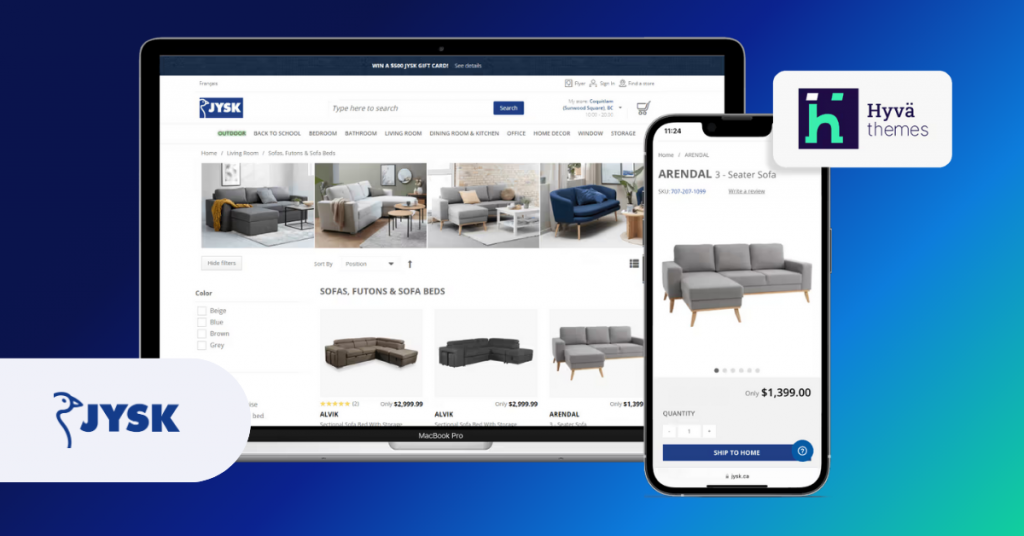
Goal: Improve performance and pass Core Web Vitals
Approach: Partial Hyvä rollout with custom Tailwind and Alpine.js work, layout-by-layout
Results:
- -2900% total blocking time
- -242% time to interactive
- All-green CWV
- +58% unique purchases
- +43.8% transactions
- +20.1% checkout conversion rate
Read the full case study here.
Pioneering award-winning digital experience for Airthings
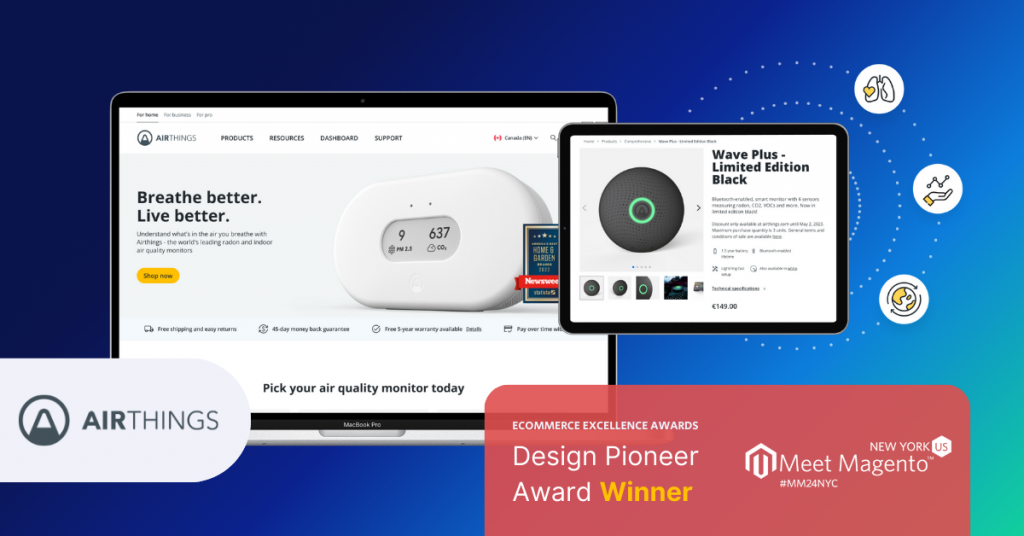
Goal: Redesign two subdomains into one customer-focused site
Approach: Full Magento + Hyvä rebuild with HubSpot CMS integration
Results:
- +103.4% transactions
- +105.5% revenue
- +56% engagement
- Winner of the Design Pioneer Award at Meet Magento NYC 2024
Read the full case study here.
Gear-Up YoY sales improvement

Goal: Migrate from Magento 1 and improve site speed
Approach: Magento 2 replatform with custom backend logic and Hyvä frontend
Results:
- +110.9% revenue YoY
- +47.7% orders YoY
- +124K clicks and 9.68M impressions
- Fully rebuilt custom logic and workflows
Read the full case study here.
ATX Fitness’ U.S. launch with Hyvä Commerce
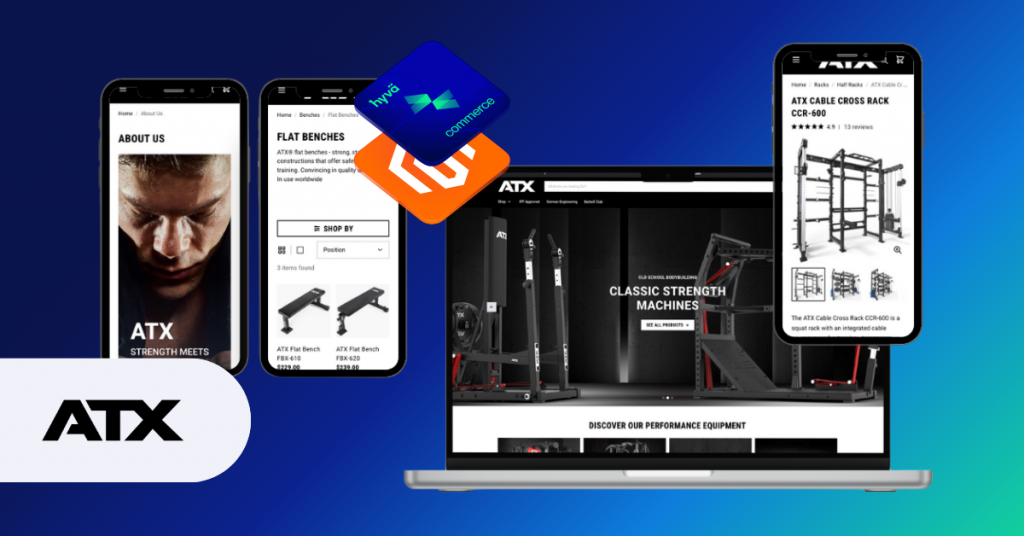
Goal: Launch a US eCommerce site in time for Home Gym Expo
Approach: Full Magento 2 build with Hyvä Commerce + Checkout
Results:
- Launched in 2.5 months
- 15+ custom features delivered
- All green CWV
- 93–100% PageSpeed accessibility scores
Read the full case study here.
Umniah eshop strengthens leadership
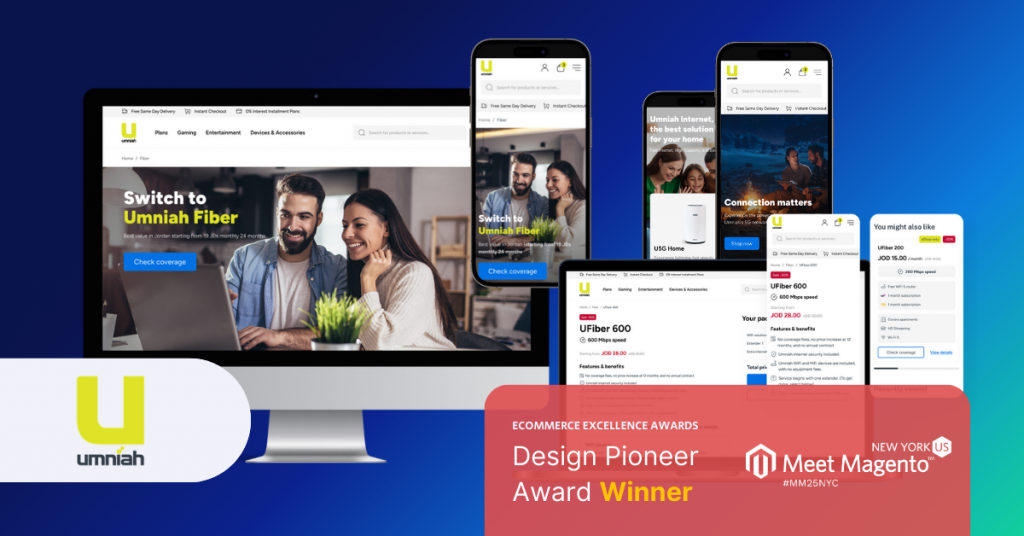
Goal: Rebuild the eCommerce store to match modern standards
Approach: Magento 2 + Hyvä + custom integrations (ERP, GIS, personalization, payment)
Results:
- +105% revenue in Internet Plans
- +86% cart-to-view rate
- +72.1% sessions
- +300 new keywords
- Winner of the Design Pioneer Award at Meet Magento NYC 2025
Read the full case study here.
Ready to build with Hyvä?
The theme is open, and the code is yours. Hyvä Theme 1.4.0 is now available on GitHub under an open-source license. You can also request free license keys from hyva.io to access extra tools and compatibility modules.
Congratulations to the Hyvä team on this release! You’ve raised the bar for everyone building on Magento, and we’re excited to keep pushing boundaries.
Want to see everything that’s possible with Hyvä? scandiweb is a Hyvä Platinum Partner with an extensive hands-on experience. Reach out to us if you’re exploring Hyvä for the first time or taking a new strategic step. We’re here to help and show a clear path to growth.
The post Hyvä Theme Goes Open Source: A Milestone for Magento Performance and Community appeared first on scandiweb.
]]>The post Omnichannel in 2026: How Connected Retail Will Drive Profitability appeared first on scandiweb.
]]>Global retailers are showing that omnichannel is no longer a strategy you experiment with but the way modern retail operates. The most profitable brands have built unified retail systems that link stores, websites, apps, and CRMs into one shared network that manages all core retail data.
With that foundation in place, every team works with the same information. Fulfillment becomes faster, personalization improves, and customer loyalty grows.
This article explains how unified commerce strategies turn omnichannel from a theory into measurable profit, with clear steps any eCommerce and retail team can apply.
Key takeaways
- Profit in 2026 will come from connected systems, not more channels, and retailers that link data, stock, and teams see real financial impact.
- Measuring omnichannel performance requires one shared view of the customer across online and in-store interactions.
- Small, connected actions (from unified loyalty to digital receipts) create fast ROI and build the foundation for sustainable growth.
The reality of omnichannel in 2026
Most retailers already have the right tools in place: a website, an app, a CRM, and a POS system. What they often lack is connection. Each tool works, but rarely together.
That gap is now too large to ignore. Customers expect stores and websites to recognize them as the same person. They want to check stock online, pick up in store, and receive offers based on everything they have bought before.
Global retailers from Europe to the Middle East now treat their physical stores as digital engines: fulfillment centers, data capture points, and loyalty drivers that feed back into online systems.
AI and unified data make this possible. They allow retailers to connect every interaction, automate decisions, and deliver consistent experiences across all touchpoints. When data moves freely, even complex operations run smoothly and profitably.
Also read:
How to Unify Offline and Online Data for Omnichannel Retail Personalization
Five key eCommerce upgrades that increase profit
1. Unify stock visibility
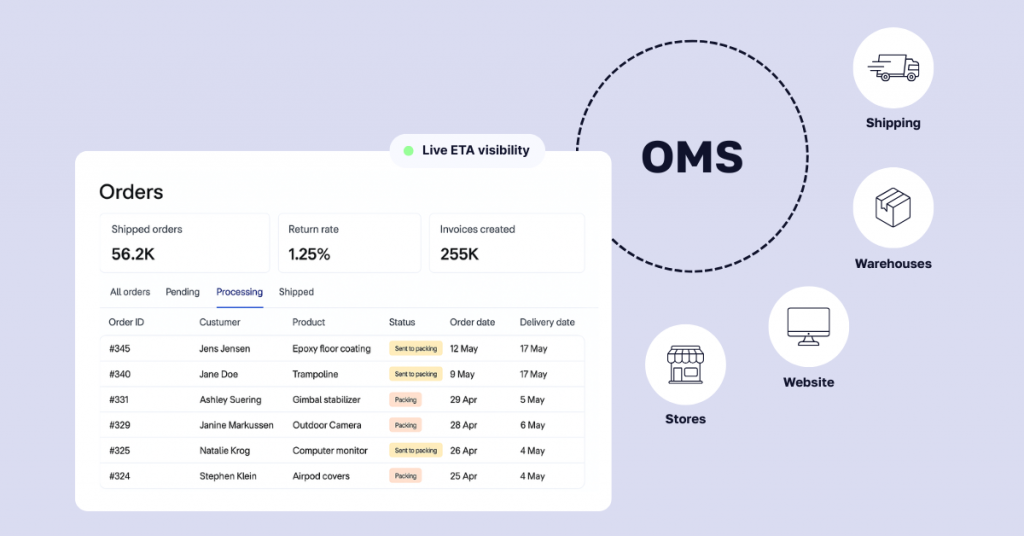
A unified stock system removes the disconnect between stores and online inventory. Integrating an Order Management System (OMS) allows real-time syncing, so every channel reflects accurate availability. Adding live estimated arrival times, such as “Arrives by 5 PM tomorrow,” gives shoppers confidence to complete their purchase.
Retailers adopting advanced OMS systems are already seeing shorter delivery windows and higher conversion rates thanks to live ETA visibility and intelligent routing that automatically chooses the fastest or most efficient fulfillment point. This accuracy also cuts refund requests caused by overselling or incorrect stock levels.
2. Ship-from-store and BOPIS/BORIS
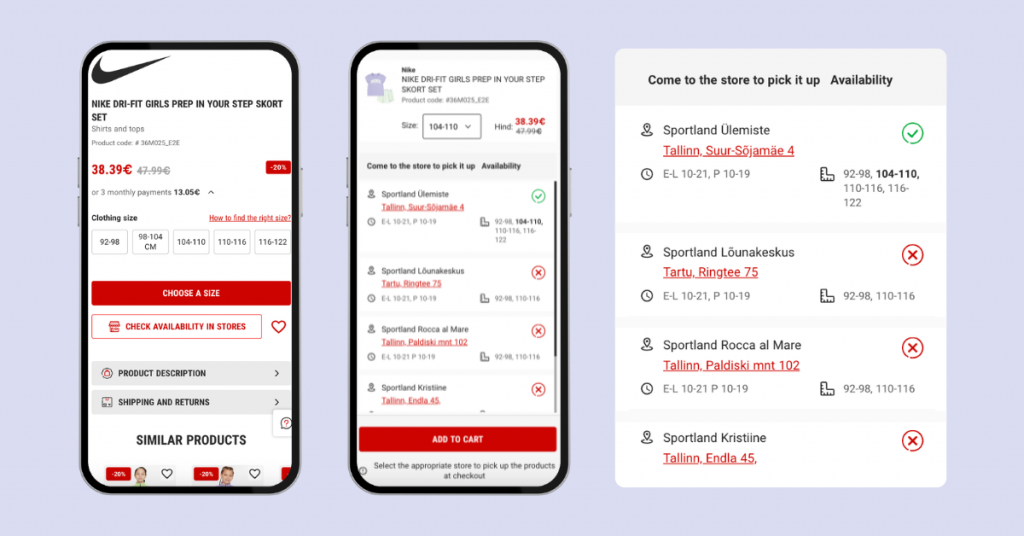
Using physical stores as fulfillment points changes how they support the sales process. When customers can buy online and pick up or return in store, both convenience and traffic increase. This model is known as BOPIS (Buy Online, Pick Up In Store) and BORIS (Buy Online, Return In Store) – two of the most effective ways to connect digital and physical retail.
Automating routing rules helps select the store best positioned to handle each order based on proximity and stock availability. Some leading retailers now fulfill most of their online orders directly from stores, which lowers last-mile delivery costs, speeds up fulfillment, and drives more visits to physical locations.
3. Cross-channel loyalty program
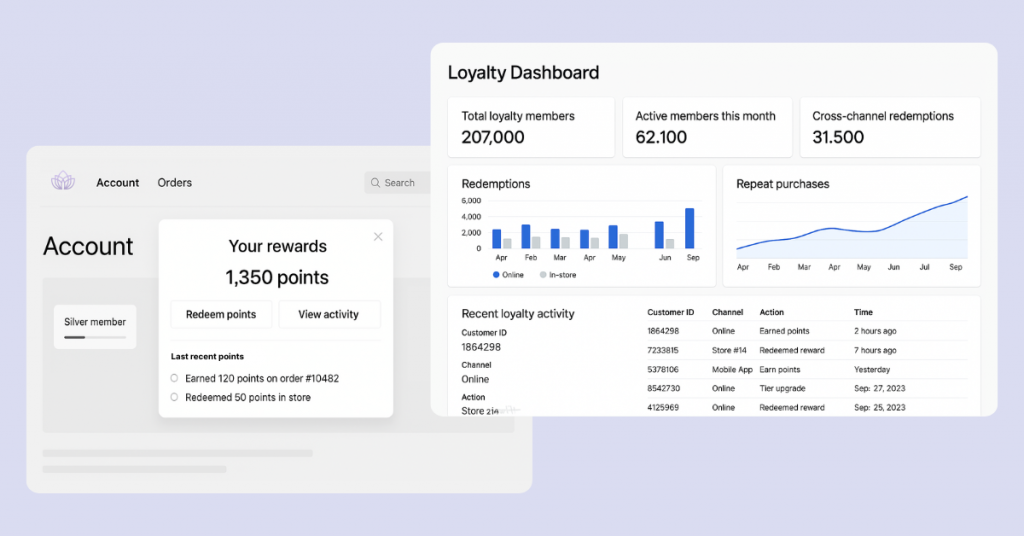
Loyalty systems are most effective when they operate across every channel. One shared loyalty wallet in both the app and POS lets customers earn and redeem rewards no matter where they shop.
These programs are now evolving into unified identity systems. Whether someone shops online or in-store, a single account records every interaction, making personalization more accurate and lifetime value easier to track. A Customer Data Platform (CDP) helps pull these interactions into one profile so offers can be triggered automatically based on behavior such as how recently they purchased or how often they return. This leads to more frequent repeat purchases and stronger long-term retention.
4. Unified digital receipts and customer timeline
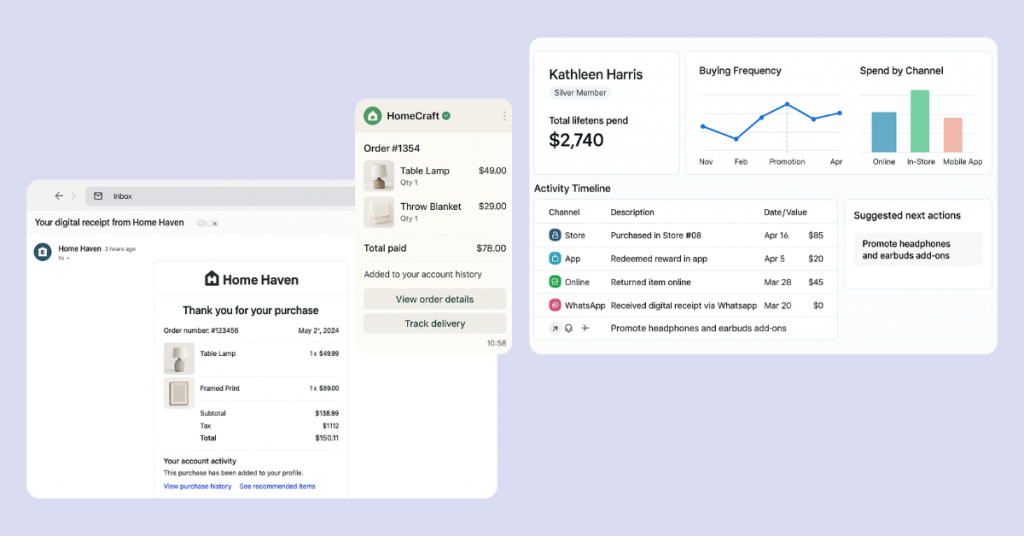
Replacing paper receipts with digital versions sent through WhatsApp or email makes each transaction part of a connected customer record. When all purchases are linked to a single account, brands can view complete buying patterns and suggest relevant add-ons at the right time.
Digital receipts are becoming more than a convenience. They are key data points linking store activity to Customer Relationship Management (CRM) profiles and ensuring service continuity across all channels. This creates stronger trust, smoother support, and automated reactivation campaigns that feel timely and relevant.
5. AI shopping assistant
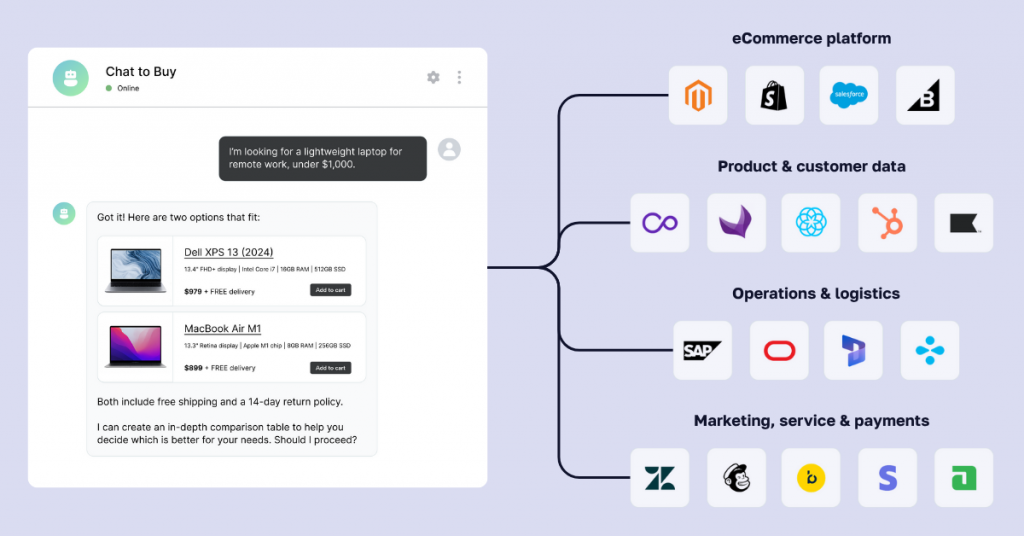
Conversational AI tools can now act as real-time shopping guides. Adding an assistant to product pages or chat apps helps customers get instant answers about size, fit, or availability and can suggest complementary items.
Retailers are seeing strong engagement when chat-based shopping tools blend human assistance with AI logic, combining service, discovery, and purchase in one seamless experience. This approach is part of a broader trend known as conversational commerce, where dialogue-driven interactions replace static browsing and help shoppers make faster, more confident decisions.
With scandiweb’s Chat to Buy solution, retailers can take this even further by enabling customers to complete purchases directly within chat. Clients using this approach have seen higher conversion rates, increased average order value, five times longer customer engagement, and a meaningful share of previously inactive customers returning to buy again.
Read more:
Case Study: Conversational Commerce Brings 31% of Churned Customers Back
Store quick wins for fast ROI
Small actions inside the store can quickly improve both revenue and customer engagement. These steps require minimal setup but deliver visible returns within weeks, like increasing average transaction value and repeat visits.
Sending a short “thank-you” message on WhatsApp after each sale keeps the interaction personal and useful. Adding product care tips or a quick how-to helps build trust without feeling like another promotion.
Handing out “surprise-me” incentive cards to customers who have not purchased in a while is another simple way to reactivate interest. A small mystery discount is often enough to bring them back.
Place QR codes around the store that let visitors check stock, redeem loyalty rewards, or view related products. Each scan connects in-store behavior to digital profiles, making future offers more precise.
Finally, offer customers the option to receive digital receipts through WhatsApp at checkout. This makes it easy for them to keep records and gives your team a direct, trackable communication channel for future campaigns.
 Quick takeaway
Quick takeaway
Small in-store actions deliver quick results. WhatsApp follow-ups, QR scans, and digital receipts help you stay connected with customers, collect useful data for personalization, and see a faster return from everyday store operations.
Making omnichannel measurable
Omnichannel success is only real when it can be measured. The goal is to see every sale, pickup, and return as part of one connected customer journey. That requires tracking performance across both digital and physical touchpoints, using data that flows in both directions.
What to track
To measure whether your omnichannel setup is working, focus on the metrics that show how customers move between channels and where value is created:
- Cross-channel redemption, such as how many in-store purchases come from customers who first interacted online
- Pickup footfall conversion, showing how many online orders lead to store visits and extra sales
- Repeat purchase rate per unified customer ID, to measure loyalty beyond a single channel
- Time to fulfillment from store versus warehouse, to identify the most efficient delivery paths.
How to measure
Combine your order management and CRM systems, so data from every channel ends up in one place. Tag offline actions, including digital receipts and QR scans, with customer IDs to make each purchase traceable and connected to the same profile.
Leading retailers go a step further by adding loyalty data to this setup and viewing everything in a single dashboard. This helps them see not just where sales happen, but how each channel influences profit and customer behavior overall.
Common blockers and how to fix them
Even well-equipped retailers struggle to make omnichannel work in practice. The issues usually come down to systems, goals, and people.
Disconnected systems
When POS, ERP, and OMS tools operate separately, information gets lost and customers notice the gaps. Connecting these systems should be the first step in any omnichannel plan. Start with real-time stock and order syncing, so every team works with the same data.
Misaligned KPIs
Online and in-store teams often chase different targets, which creates internal competition instead of collaboration. Set shared metrics such as pickup revenue, customer lifetime value, or fulfillment speed. When both teams benefit from the same results, coordination improves automatically.
Read more:
How to Avoid Internal Sales Cannibalization Between Online & Offline
Change resistance
Resistance usually comes from habits, not technology. People support new processes when they understand how it makes their work easier or more rewarding. Focus on clear incentives, such as faster service or simpler sales tracking.
Tie performance rewards to real omnichannel results, for example, acknowledging store staff who fulfill online orders or turn pickups into extra sales. Keep training simple and centered on daily tasks.
 Quick takeaway
Quick takeaway
Fix systems first, align goals second, and make adoption rewarding. When tools, metrics, and people are connected, omnichannel starts working as one business, not two.
Conclusion
Omnichannel profitability is now a proven outcome. Retailers that have unified their systems and teams are already seeing stronger growth, steadier margins, and clear improvements in customer retention.
The goal is not to appear in every channel, but to connect the right ones through shared data and coordinated operations. The retailers who understand where their customers are, and act when they engage, are the ones turning connection into profit.
Want to make omnichannel profitable for your business? Contact us, and we’ll map out the steps needed to unify your data and bring your eCommerce and retail operations into one revenue-driving system.
The post Omnichannel in 2026: How Connected Retail Will Drive Profitability appeared first on scandiweb.
]]>The post Is Your Brand Visible in ChatGPT? Introducing the AnswerRank Leaderboard appeared first on scandiweb.
]]>Does ChatGPT recommend your brand to customers?
That question used to sound futuristic. Today, it’s urgent. AI assistants like ChatGPT, Gemini, and Perplexity are already really influencing buying decisions. They’re replacing Google searches with natural conversations and AI-generated recommendations, and customers trust them.
What’s inconvenient is that brands don’t get notified when they’re mentioned – there’s no dashboard showing how AI tools perceive them, or whether they appear at all. And when they do show up, the facts might be wrong, outdated, or biased toward competitors.
The current situation inspired the creation of AnswerRank, our AI search monitoring tool. We wanted to bring clarity to an unpredictable space and demonstrate to brands how they appear in AI-generated answers, while also providing clear, actionable ways to improve.
The problem with AI search
AI search introduces an entirely new logic to optimization. The main reason is that ChatGPT and others don’t behave like Google, e.g., by showing a list of links or highlighting ads. Instead, they generate a single, authoritative-sounding answer. Where that answer comes from and why it mentions one brand over another is often a black box that even experienced SEO professionals are struggling to decode.
- Each AI engine is trained differently – ChatGPT, Gemini, and Perplexity use different models, data sources, and logic.
- Answers change without warning, so a brand that shows up today might disappear tomorrow.
- AI can invent facts, hallucinate citations, and confuse brand names.
- There used to be (until AnswerRank) no visibility to track where your brand appears, how often, or how it compares to competitors.
The solution: AnswerRank
AnswerRank is a tool built specifically to track how brands appear in AI-generated answers and help them show up more frequently, with more control.
Developed by SEO experts with 20+ years of experience, AnswerRank was born out of frustration with how unpredictable and unaccountable AI search had become. If people are asking ChatGPT where to shop, what to buy, or who to trust, brands deserve to know how they’re showing up in those answers, and what to do about it.
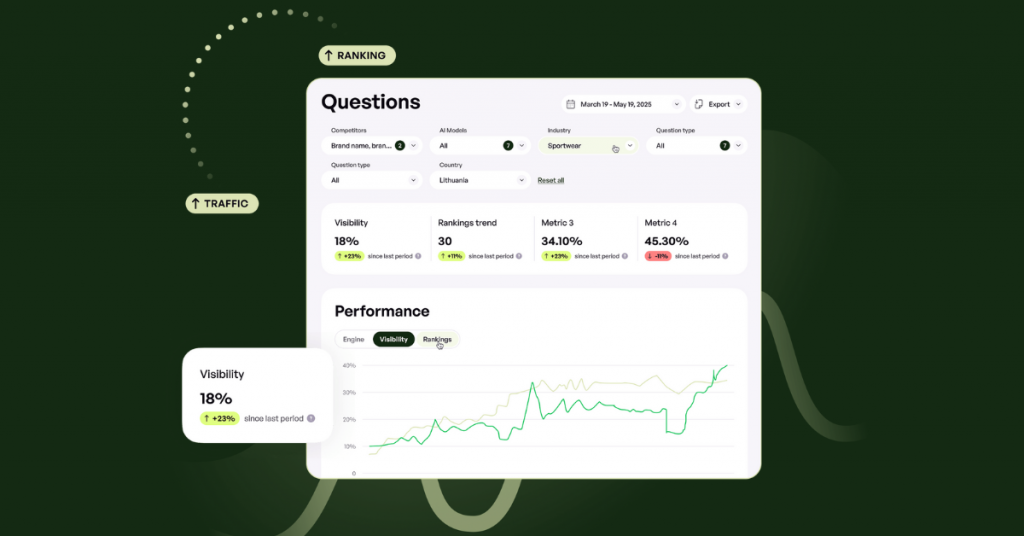
What you can do with AnswerRank:
- Track your brand’s visibility across ChatGPT, Gemini, and Perplexity
- Benchmark against competitors to see who’s winning
- Analyze sentiment to understand how AI tools portray your brand’s voice
- See sources and citations used by AI to generate answers
- Generate optimized answer snippets that help LLMs interpret your brand accurately
- Get improvement suggestions backed by expert logic.
AnswerRank takes the data and creates a plan. Then, during 1:1 sessions with an AEO strategist, brands can interpret the results and develop a personalized action plan to improve rankings across AI tools.
Also read:
Tracking Brand Mentions in LLM AI-Generated Answers
Coming soon in AnswerRank
As the technology behind AI-generated answers continues to change, AnswerRank is building new tools to help brands keep up. Stay tuned, as several powerful features are already in development to go beyond visibility metrics and deliver deeper insights:
- Semantic query grouping to understand how AI clusters customer questions by intent, helping you tailor content to how people actually think and ask
- Answer theme clustering to see which topics dominate AI answers about your brand or industry, and which ones you’re missing out on
- AI answer snippets to generate optimized answers that align with how ChatGPT and others structure replies
- Real-time insights to catch shifts in visibility as they happen.
AnswerRank live leaderboard
To help brands understand their current standing and what’s possible, we launched the first AI Search Visibility Leaderboard for the Baltic region.
The leaderboard reveals which brands are already showing up in ChatGPT, Gemini, and Perplexity when customers ask real-world questions like:
“Where to buy running shoes in Latvia?”
“Best gifts for a 3-year-old in Lithuania?”
“Which supermarkets are cheapest in Estonia?”
We analyzed over 1,000 brands across 25 industries, using 40 AI search queries per sector. The ranking reveals how visible each brand is in AI-generated answers, ranked by:
- Visibility percentage – how often the brand is mentioned
- Ranking position – whether it appears in the top result
- Sentiment – how the brand is described
- AI source citations – what content influenced the result.
The leaderboard is live and updated regularly, explore it at leaders.answerrank.ai.
Key findings from the leaderboard
Latvia
The top 10 most visible brands in AI-generated answers include a mix of international giants and regional leaders: Lidl, Decathlon, Rimi, Sportland, Douglas, Drogas, IKEA, 1A, Swedbank, Kursi, and Autodoc.
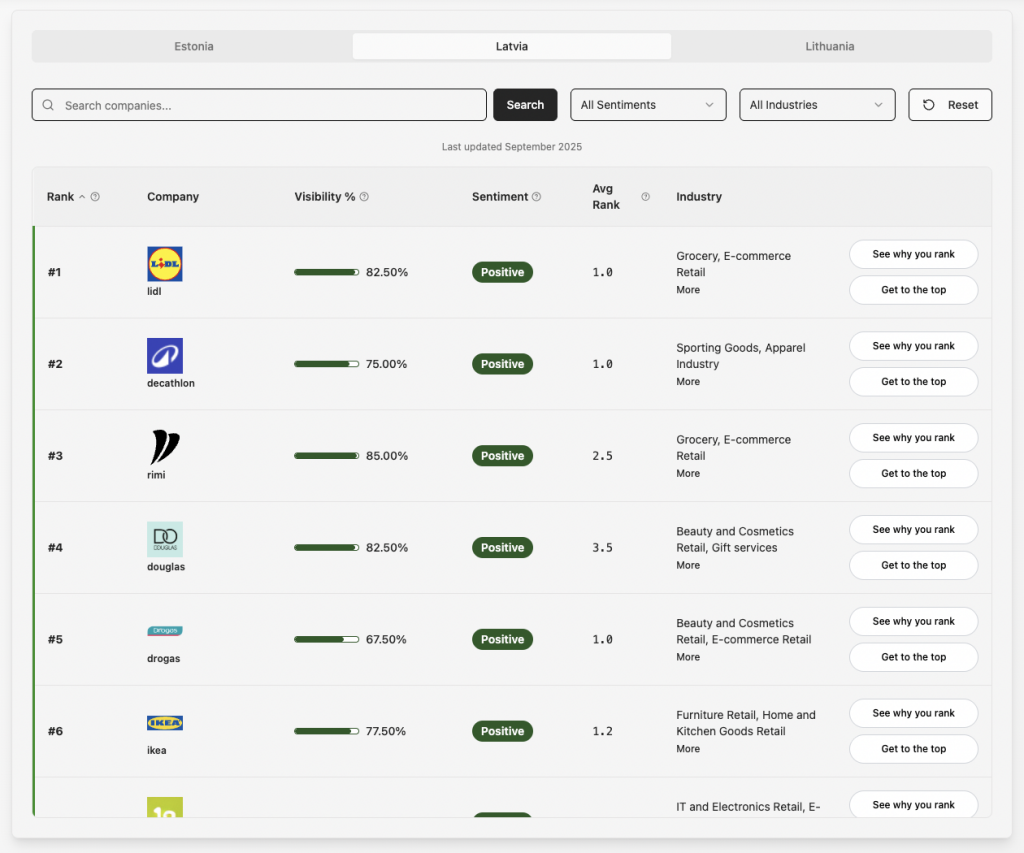
Some of these brands achieve over 80% visibility across tools like ChatGPT and Perplexity, consistently appearing in top responses to common customer questions. Others in the same categories barely register at all.
Top-performing industries:
- eCommerce Retail with 22 of the top 100 brands; Lidl at the top
- Children’s Products – 14 brands, including Babycity
- Beauty & Cosmetics – 12 brands, with Douglas at the top
- Gift Services – 12 brands, led by Lieliska Dāvana
Sectors falling behind: Healthcare Services, HoReCa, and Wholesale Retail.
Estonia
Estonia’s top-ranking brands in AI search are largely from the ticketing and events industry. Fienta (#1), Piletitasku (#3), Piletilevi (#4), and Piletikeskus (#15) all rank within the top 20, showing high visibility and strong average positions.

While eCommerce brands are present, their visibility is more scattered compared to Latvia. Notable retail performers include:
- Rahva Raamat (#2) – strong cross-category presence in Books and Media and eCommerce Retail
- PetCity (#5) – best-performing Pet Retailer
- Motonet (#7) and Autodoc (#9) with solid visibility in Auto Parts & Accessories
- Kaup24 (#8) and IKEA (#23), representing General Home & Kitchen Goods.
Still, many well-known retail names such as Selver (#32) and Sportland (#19) are further down the list with 32.5% visibility or less, suggesting room for growth in AI-driven discoverability.
Home Improvement and DIY have multiple entries (Puumarket, Bauhof, K-Rauta), signaling growing AI recognition of this vertical. Beauty and Cosmetics Retail (e.g., MyLook, Notino, ilu) is gaining traction, but with moderate visibility, none surpassing 36%.
Lithuania
In Lithuania, the AnswerRank leaderboard reveals a strong showing from local and regional champions, many of which outperform global players in AI visibility. The top three brands include pet supply chain Kika (80.42%), ticketing service Tiketa (80%), and Bilietai.
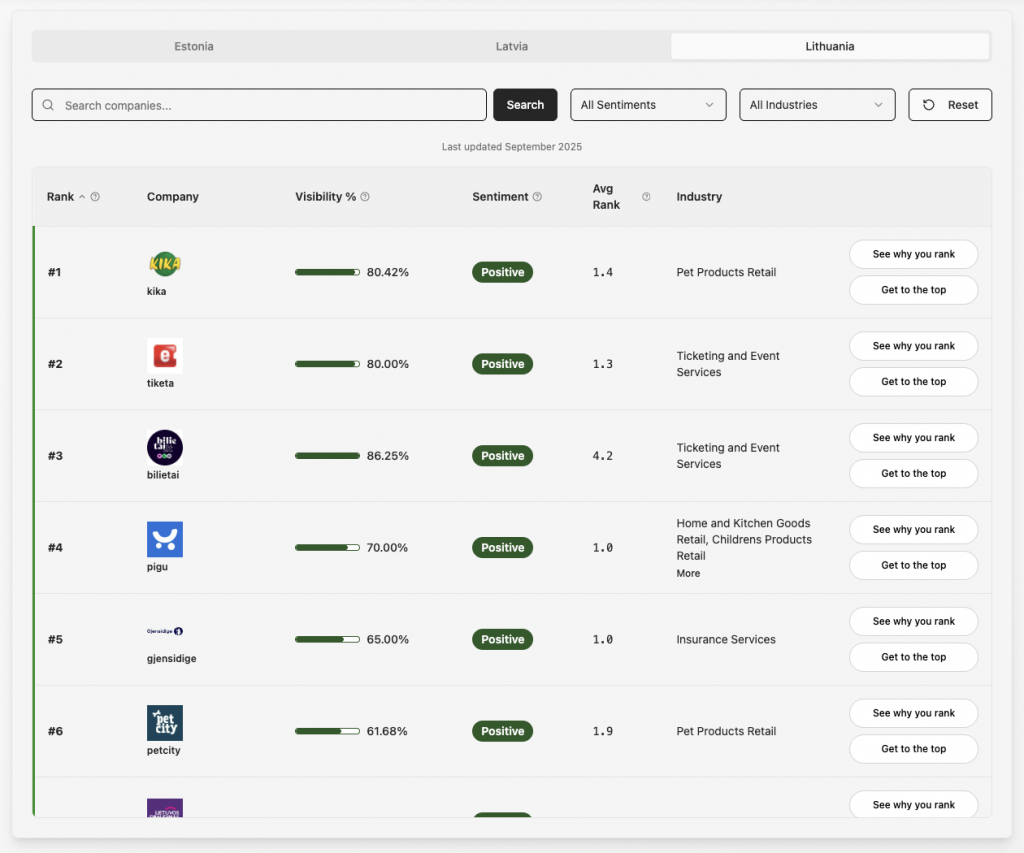
Gjensidige, Lietuvos Draudimas, and Ergo all rank in the top 10, showing that even highly regulated industries can be visible in AI-generated results when content and mentions align.
Retail categories perform well overall, but there’s a noticeable tilt toward specialized verticals. Pet product retailers like Kika, PetCity, and Pet24 appear consistently in the top 25. Similarly, Beauty and Cosmetics is a strong category, with Douglas, Notino, and Drogas close to the top.
Global grocery chains, such as IKI, Maxima, and Lidl, rank lower despite having high brand awareness. This suggests that in AI search, local relevance and content structure may outweigh pure brand recognition. As AI-generated answers increasingly guide customers toward purchases and decisions, the Lithuanian leaderboard illustrates the value of early visibility and how local players are capitalizing on the opportunity.
How brands can influence AI search
Just like traditional SEO, visibility in AI-generated answers is related to the information these models consume. What shows up in AI answers is determined by a mix of:
- Foundational training data (what the LLM was trained on)
- Web-crawled content (recently indexed online data)
- Owned eCommerce data (your product catalog, site structure, FAQs, etc.)
- External signals (brand mentions, reviews, local sources, media, social)
Brands that want to influence LLM responses need to strategically engage across these layers.
Here’s our 6-step framework to begin improving your presence in AI answers:
- Choose your LLM focus
Start with the engines your customers are actually using (whether it’s ChatGPT, Gemini, Perplexity, or another); each has different behaviors and training methods.
- Define target prompts
Figure out the types of questions your ideal customers ask and which ones you want to be the answer to. Think like a customer, not a marketer.
- Benchmark visibility
Use tools like AnswerRank to assess your brand’s visibility today in various search engines and prompt types, and identify any gaps.
- Speak with LLMs
Optimize your site structure, content, and product data to reflect how LLMs understand and rank information – format for snippets, use semantic cues, and write in clear, human-first language.
- Understand sources
Analyze which sources AI tools rely on to form their answers. Are they quoting your competitors? Are you mentioned in relevant media or directories? This step is essential to understanding how authority is calculated in the absence of traditional search rankings.
- Actionize content & strategy
Translate your insights into changes: update product descriptions, restructure category pages, publish answers to customer questions, and strengthen your brand’s digital footprint through strategic partnerships and earned media.
These six steps form the basis of AEO (answer engine optimization). With the right approach, brands can go from being invisible to becoming the top AI-recommended choice.
Brands that track and improve their visibility are the ones to be recommended most. In a world where customers increasingly ask ChatGPT what to buy or where to go, being part of the answer is everything.
Your customers are asking AI – make sure the answer is you! Try AnswerRank, or book a free 1:1 strategy session with an AEO expert today.
The post Is Your Brand Visible in ChatGPT? Introducing the AnswerRank Leaderboard appeared first on scandiweb.
]]>The post PPC Case Study: Amazon Launch Setup for CircuitMess’s Full Product Catalog appeared first on scandiweb.
]]>A tech-education brand turned to scandiweb to prepare their entire product lineup for launch on Amazon. They needed a polished, optimized Amazon presence that reflects the brand’s hands-on learning mission while meeting all marketplace requirements.
We developed listing content, visuals, and A+ modules for the entire catalog, navigating outdated Amazon tools to ensure every detail met technical and brand standards.
About
CircuitMess designs and manufactures DIY electronics kits that teach coding, robotics, and hardware basics through play. Their products range from programmable game consoles to AI-powered robots and other interactive kits, making STEM learning accessible and fun for kids and adults. With a growing customer base across D2C and retail channels, CircuitMess aimed to expand to Amazon with a storefront that communicated value, sparked curiosity, and converted browsers into buyers.
Project goals
To prepare for the Amazon launch, CircuitMess needed:
- Complete product listings for its full catalog, optimized for organic visibility
- A+ content that reflects the brand’s educational value and visual style
- Consistent listing structure to scale easily in the future
- Compliance with Amazon’s technical listing requirements
- Accurate categorization and keyword targeting for better discoverability.
Approach
Because Amazon’s flat file templates are prone to formatting errors, much of the setup required manual adjustments, especially when mapping CircuitMess’s educational product types to Amazon’s default categories. Rather than treat this as a barrier, we embedded QA directly into each step of the process to maintain consistency and reduce risk.
Here’s how we delivered:
Content strategy & keyword research
Mapped relevant search behavior to the client’s products using Amazon data and third-party keyword tools. The insights we gathered were later used in copy, prioritizing visibility and intent match to improve discoverability.
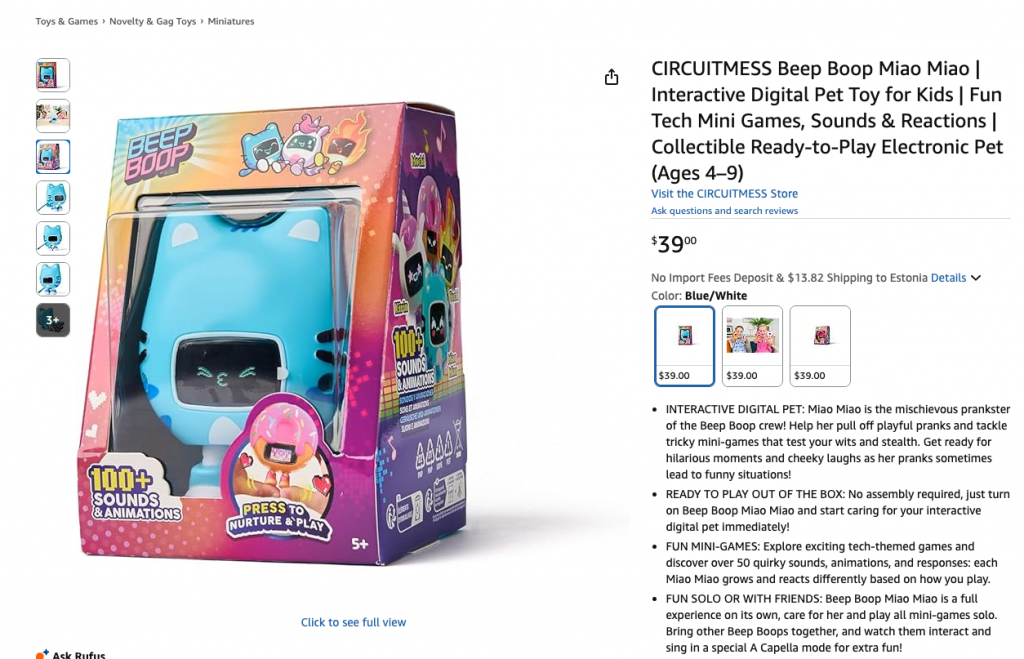
Product copywriting
Created unique, benefit-led content for each item, tailored to Amazon’s character limits and buyer decision patterns. Every listing balances SEO with brand tone, helping buyers understand what the kit does and why it matters.
A+ content creation
Designed custom modules for every product, describing learning outcomes and kit contents and highlighting user experience. These modules enhance the listings visually and help drive conversions through engaging, educational storytelling.
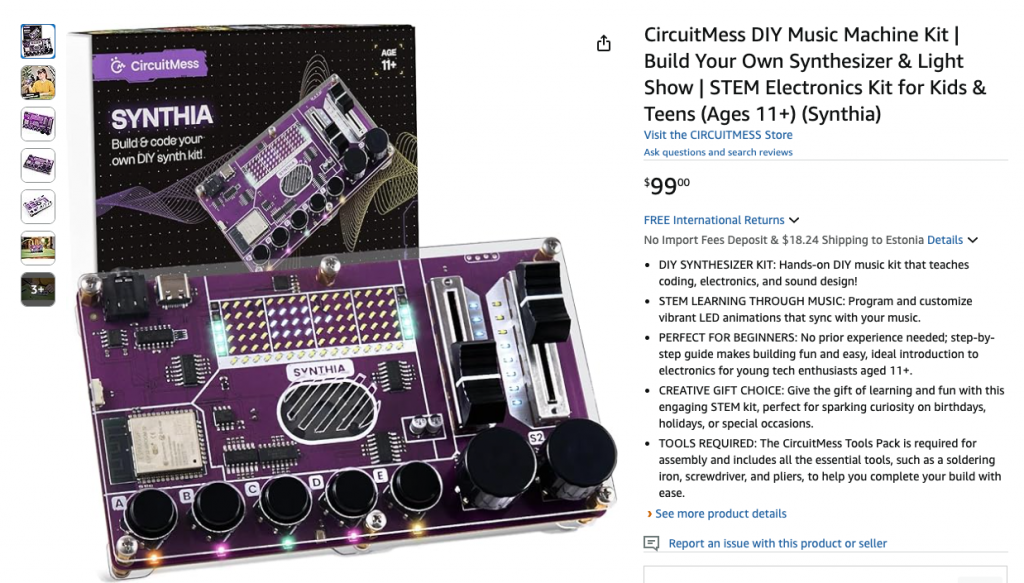
Technical setup & upload
Used Amazon’s flat files for bulk uploads, correcting categorization conflicts, formatting errors, and ensuring data validation across product variants and bundles.
Visual formatting
Aligned all product images with Amazon’s technical standards and visual best practices. Lifestyle and in-use photos were added to reinforce educational outcomes and appeal to parents and hobbyists.
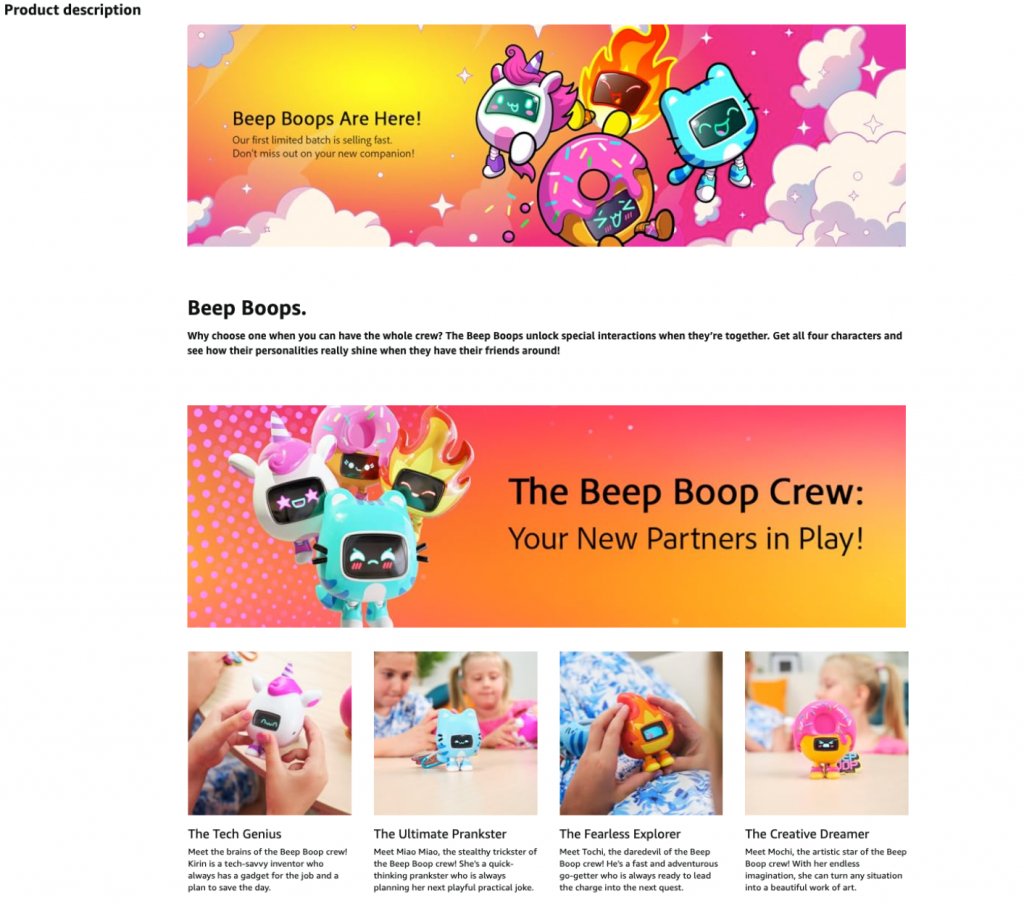
Full QA before launch
Each listing went through a comprehensive review to confirm accuracy, design consistency, keyword alignment, and mobile display optimization.
Results
CircuitMess now has a fully built and fully compliant Amazon catalog, with every product set up for success from day one:
A complete Amazon presence for the entire product catalog
- Fully keyword-optimized content tailored to each listing
- Custom A+ content across all products
- Visuals that reflect the brand’s identity and improve conversion
- Future-ready listing structure for scalable catalog expansion.
The setup serves as a strong foundation for upcoming Amazon campaigns, providing a consistent and high-quality customer experience that aligns with CircuitMess’s D2C standards.
This case study was prepared by Ahmed Tantawy and Abduallah Qobaisy.
Interested in launching your first product on Amazon or scaling a multi-SKU catalog? Let’s chat and build a presence that communicates value and converts shoppers.
The post PPC Case Study: Amazon Launch Setup for CircuitMess’s Full Product Catalog appeared first on scandiweb.
]]>The post Chat to Buy: The Future of eCommerce Is Conversational appeared first on scandiweb.
]]>eCommerce has come a long way, but so have customer expectations. Let’s be honest, shopping online still isn’t as seamless as it should be and often requires too many clicks and questions that go unanswered. As a result, shoppers drop off.
In contrast, conversations feel easy. When we need advice, we ask a friend; it’s the same with wanting a recommendation from a store. A growing share of product discovery (over 70% for ChatGPT users) now starts in chat. Not on a homepage or a search bar, but in a conversation. Amazon, Zalando, and other global retailers are already piloting buying via conversational commerce, the practice that lets customers shop through real-time chat powered by AI.
At scandiweb, we believe this is the biggest shift in eCommerce since mobile. And we’re not just watching it happen, that’s not how we like to do things around here! We are making it happen.
What is conversational commerce?
Conversational commerce is exactly what it sounds like: shopping through conversation. But not just any conversation, one that’s powered by AI, personalized in real time, and available everywhere your customers are.
Instead of navigating a maze of menus, filters, and product pages, customers can simply type:
“I need a jacket for rainy weather.”
AI picks up the request, asks a follow-up question or two, checks real-time stock and prices, pulls data from past orders, applies loyalty perks, suggests the perfect product(s), and keeps the conversation going. Each interaction becomes a high-converting sales moment, not a support ticket like we’re used to in relation to chatbots. Conversational commerce drives faster decisions and repeat purchases.
Here’s conversational commerce explained in more detail.
Steps of an AI-powered buying journey
Let’s break down what happens in these chats:
- Discovery
A shopper sends a simple message: “Need something for a DIY deck project.” (Or AI starts the conversation first, and then reacts based on the customer’s response).
- Understanding
The AI recognizes intent, even if the request is vague or misspelled, and pulls context from past orders, location, and preferences.
- Personalized offer
Based on product data and real-time availability, the AI recommends options, upsells smartly, and bundles products for convenience.
- Assistance & guidance
The AI answers sizing questions, compares features, and explains return policies, just like a helpful salesperson would.
- Ongoing relationship
AI can reingage, or the next time the customer comes back, in chat, your site, or in-store, the conversation picks up where it left off.
But most conversational tools today offer isolated experiences, like a chat widget on a website, a messaging bot in one app, or a support assistant with limited replies that rarely remembers who the customer is when the channel changes, and they almost never close the loop on the sale.
Chat to Buy brings one continuous, engaging conversation to every channel. The same AI assistent follows the shopper, remembers their history, understands their behavior, and helps them complete their purchase.
Introducing Chat to Buy
Chat to Buy is scandiweb’s conversational commerce solution made for omnichannel retailers. It connects every customer touchpoint – web, apps, messaging, kiosks, and in-store – into a single ongoing conversation powered by AI. No matter where someone shops or what they need, the experience is context-aware, personalized, and consistent.
And more importantly, it’s also a way to sell.
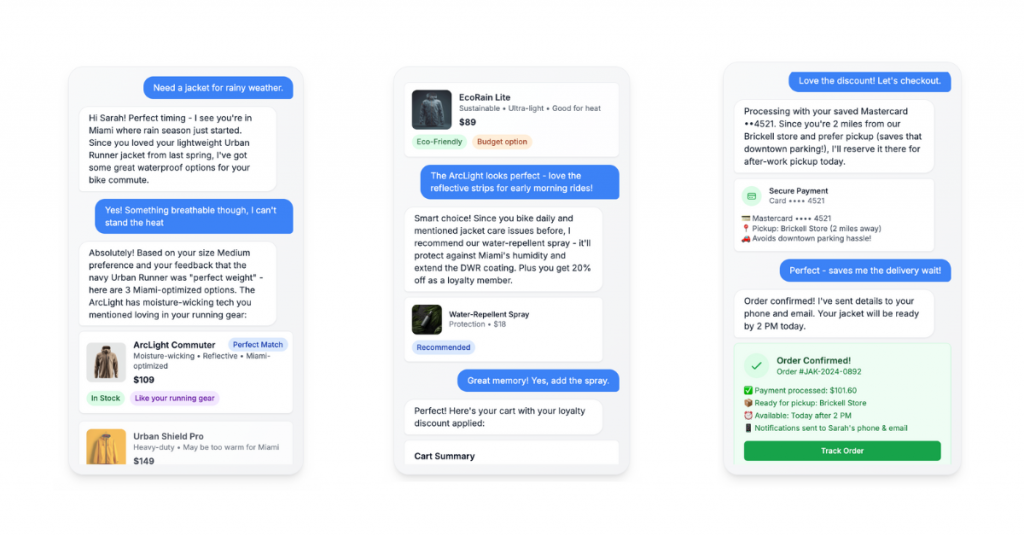
While most chat tools stop at product suggestions or support answers, Chat to Buy guides the whole journey from re-engagement and discovery to real-time stock checks, upsells, and completed purchases, all within the same thread. It’s designed to increase order value and reduce drop-off, without interrupting the customer experience or adding work for your team.
How Chat to Buy makes selling easier
Traditional eCommerce often resets the customer journey every time someone returns. Their preferences and cart disappear, and questions get asked and re-asked across different channels. Chat to Buy keeps the conversation alive, connecting every touchpoint with a single AI-driven system that remembers the customer and makes it easy to complete a purchase. Here’s the impact it has:
- Higher conversion rates – when customers can ask questions and get answers about products, stock, delivery, or policies in the moment, they’re more likely to buy.
- Bigger order value – AI introduces relevant bundles and higher-margin items naturally within the conversation.
- Bring back inactive customers – Chat to Buy uses purchase history and behavioral signals to reach out via WhatsApp, SMS, or email at just the right time.
- Fewer returns – when customers get real-time help during the decision process, they’re less likely to send products back.
- Lower support load – routine questions, such as order status, returns, loyalty balance, are handled automatically.
- Unified channels – Chat to Buy remembers the whole history, regardless of whether a customer starts on your website, switches to WhatsApp, or walks into a store.
- Faster checkout help – customers get the clarity they need about payment options, delivery times, etc., right when they need it.
- Smarter campaigns – what people ask and convey in these chats can be turned into smarter segmentation and more relevant targeting.
- Lasting competitive edge – Chat to Buy helps you capture and retain first-party data that no one else has, giving you an advantage in personalization and retention.
Why alternatives fall short?
 Other tools Other tools |  Chat to Buy Chat to Buy |
|---|---|
| Built for a single channel only | Works across all customer touchpoints |
| Lose context when switching platforms | Maintains memory in every channel and visit |
| Handle only basic support or FAQs | Runs re-engagement, upsells, onboarding, checkout |
| Require a DIY setup that breaks easily | Delivered, customized, and maintained by scandiweb |
| Don’t scale for multiple markets or teams | Built for multi-language, multi-market enterprises |
| Limited integrations, no real-time data | Connects to your store, CRM, PIM, and analytics |
How Chat to Buy works
Chat to Buy is built in three layers: the core AI engine, the business logic that forms how it works for your goals, and the interfaces that meet your customers wherever they shop.
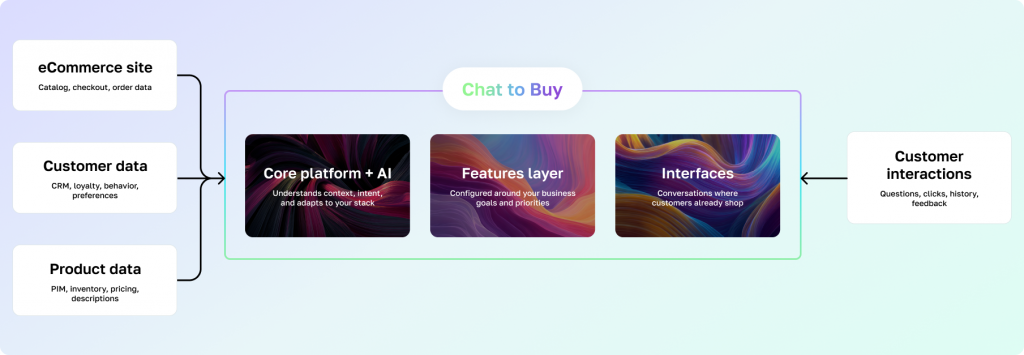
Foundation layer: core platform & AI
At the core is a powerful AI engine trained on your store data and customer behavior, making the experience feel personal, relevant, and reliable in any language and at any time. The AI agent can:
- Pick up on vague, incomplete, or typo-ridden messages with 95%+ accuracy in 100+ languages
- Remember customer past orders, preferences, loyalty points, and other data
- Support 50+ behavioral signals and cross-channel memory
- Pull live pricing, stock, delivery options, and loyalty perks from your systems
- Track everything via built-in conversation logging, privacy controls, and performance reporting to help you measure impact and stay compliant.
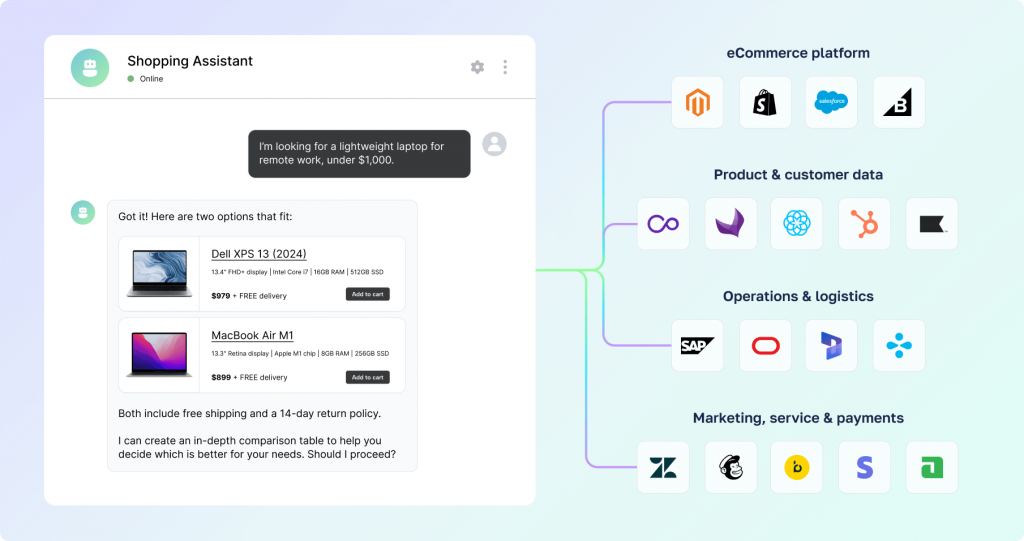
Features layer: your unique needs
No two retailers use Chat to Buy the same way. The second layer adapts the experience based on your priorities, including:
- Automatically reaching out at the right time with relevant reminders and personalized offers to re-engage inactive customers → ~20% reactivation in the first month (10x better than email).
- Suggesting upgrades and bundles naturally within the conversation, not as a last-minute push → 15–30% higher average order values.
- Answering questions about order status and more → 40–60% reduction in support tickets.
- Adding any features you need, such as connecting to your CDP, running onboarding flows, or handling store-specific rules.
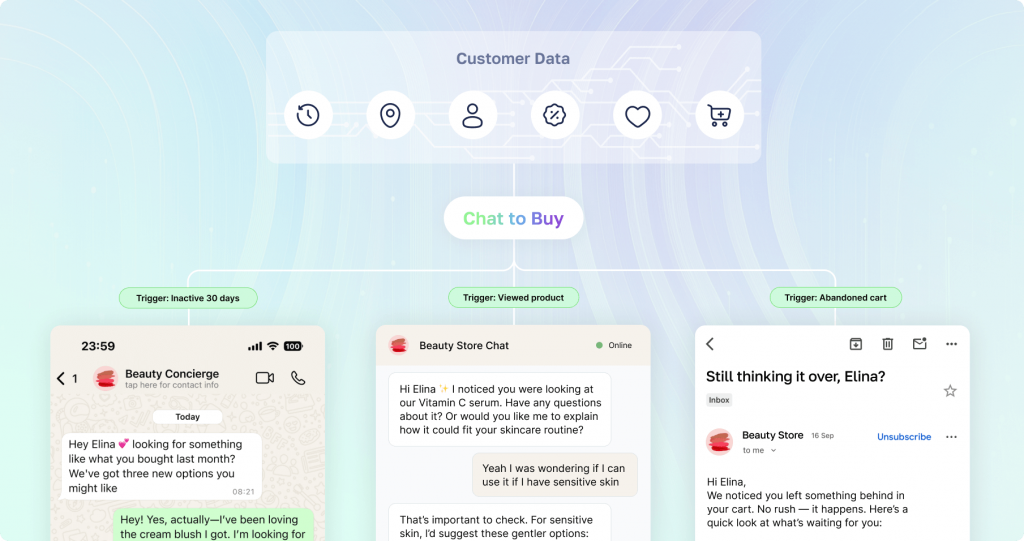
Interface layer: sales & customer touchpoints
Your customers don’t shop in one place, and they shouldn’t have to start over every time they switch channels. Customers can ask a question at the store, later receive a follow-up via email, and then chat and reorder through WhatsApp, without ever repeating themselves. The interface is powered by the same AI and memory throughout and brings Chat to Buy to all your touchpoints:
- Website
- Mobile app
- SMS
- Voice
- Kiosks
- In-store devices
- …or anywhere you want it!
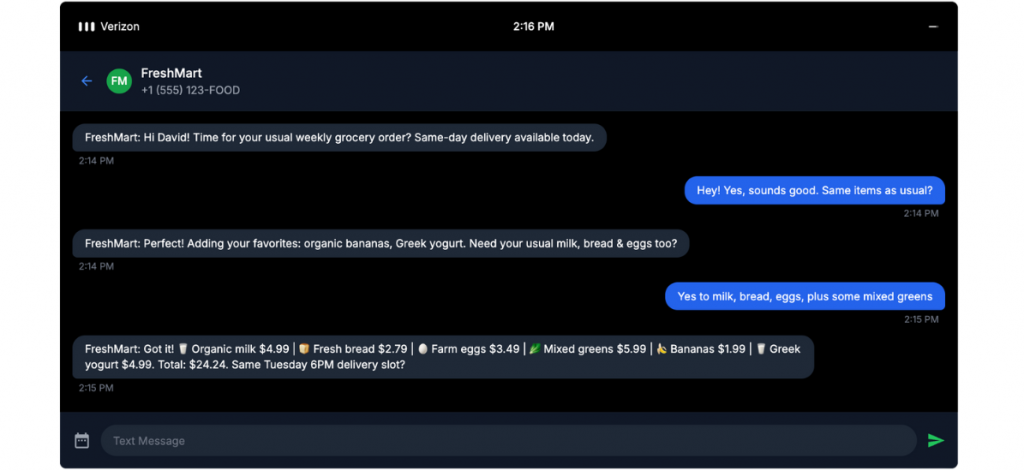
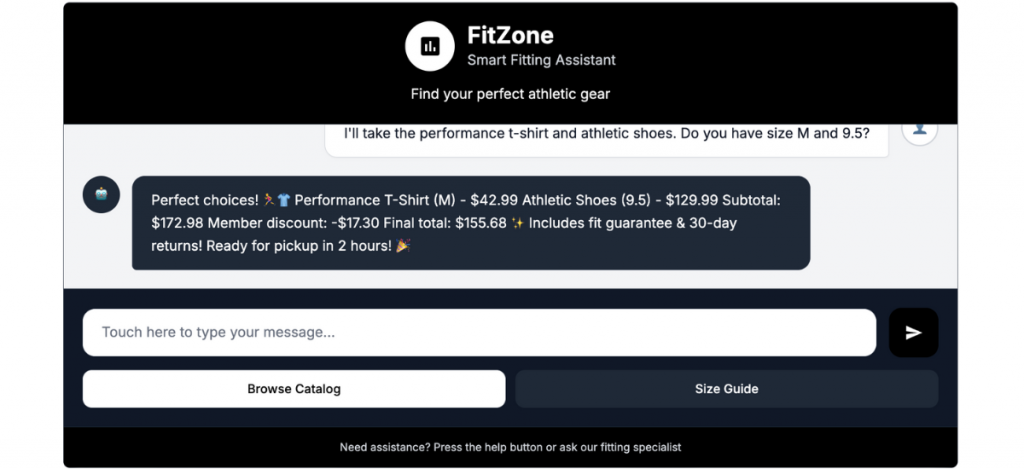
Chat to Buy in practice
Solving complex DIY needs
Our client, a leading DIY and home improvement retailer from the Nordics, wanted to support customers working on complex projects without increasing their support team or sacrificing personalization. With thousands of SKUs and seasonal surges in demand, many shoppers needed step-by-step help, like:
“What do I need to build a deck?”
“Which screws work with this board?”
“Is this paint outdoor-safe?”
“How much wood do I need for 12 square meters?”
“Can I pick this up in-store tomorrow?”
Instead of sending them to a support page or hoping they’d figure it out, we helped our client launch an AI-powered project assistant using Chat to Buy, trained on real customer journeys and common DIY builds, and connected directly to the live catalog.
Results
- One intelligent conversation that guides users through entire projects
- 5x longer average session time
- Increased conversion rates and AOV
- Less dependency on seasonal staff.
Re-engaging churned customers
Zorro offers premium pet food and care products for dogs and cats. They cater to pet owners who value purity, dietary specificity, and premium quality, often serving customers whose pets have sensitive or selective needs. With a loyal customer base but a naturally spaced-out reorder cycle, Zorro faced a familiar DTC challenge. How to win back churned customers and increase repeat purchase frequency? But do so efficiently, without over-relying on generic emails or broad remarketing campaigns.
Using Chat to Buy, Zorro launched an AI-powered WhatsApp sales concierge integrated with their CDP and purchase data. It allowed them to:
- Identify lapsed customers based on timing and order history
- Send highly relevant messages at just the right moment
- Carry out the full conversation (product discovery, questions, suggestions, upsells, and reorder) inside WhatsApp, without losing context.


For a brand built on quality and care, Chat to Buy became a natural extension of their customer experience.
Results
- 32% reactivation of churned customers
- Repeat purchases driven through ongoing, personalized chat engagement
- Live in just 2 weeks from kickoff to launch.
The future is conversational
Traditional eCommerce expects customers to figure it out on their own, and that experience costs businesses in missed sales and low retention.
Chat to Buy brings together the tools and context needed to support a purchase from the very first question. It understands what each customer is looking for and keeps the conversation going with relevant data, no matter where they shop.
For brands, that means higher conversions, larger baskets, more returning customers, and fewer support tickets.
For customers, it feels like having a helpful assistant that already knows them and what they want.
The time to act is now. Ready to launch a better way to sell? Get a personalized demo and see how Chat to Buy works with your goals. Prefer to start with a conversation? Reach out to [email protected], and let’s talk!
The post Chat to Buy: The Future of eCommerce Is Conversational appeared first on scandiweb.
]]>The post Case Study: Dated Magento 1 Migration to a Modern Magento 2 Experience for B2B Buyers appeared first on scandiweb.
]]>When B2B eCommerce platforms become too customized to upgrade, they stop being assets and start becoming blockers. Over time, even once well-functioning systems can become hard to maintain and risky to scale. We often see this in long-running Magento 1 setups, where there is no clear path to upgrade and rising concerns around security and compliance.
Cook Medical needed a platform that could handle the complexity of selling medical devices without making it feel complex. We partnered to rebuild the entire experience on Magento 2, introducing a modern, stable interface with minimal customization, seamless ERP integration, and a new analytics foundation to help internal teams understand how the store was being used.
About
Cook Medical is a family-owned and globally recognized manufacturer that supplies hospitals and healthcare providers with medical devices used in minimally invasive procedures, with a product catalog of more than 15,000 items across various specialties.
Their eCommerce platform isn’t public-facing. Access is restricted by user role, and buyers can only view and purchase products tied to their specific clinical division. That level of control is essential in regulated environments, but it also adds complexity.
Cook Medical’s Magento 1 site had become difficult to maintain and technically fragile. It had reached a point where maintenance and upgrades were no longer practical – years of deep customization made it impossible to upgrade without risking instability or security gaps. The main objective of the migration was to reduce custom code for a cleaner, maintainable Magento 2 setup that could be easily updated and kept secure.
Additionally, limited visibility into product data meant teams couldn’t easily track what users were doing or what they needed.
Project goals
The move to Magento 2 was driven by the need to create a stable foundation, one that would be secure, easier to maintain, and ready for future growth. Key project objectives:
- Rebuild the storefront on Magento 2 with minimal customization to simplify future upgrades
- Migrate 15,000 SKUs and historical data from Magento 1 to Magento 2
- Maintain strict security standards across all system components
- Integrate with SnapLogic middleware for ERP and order data sync
- Preserve strict access rules across medical divisions with role-based permissions
- Make pricing and availability visible at the product listing level
- Introduce site-wide behavior tracking with GA4 and a compliant consent setup
- Improve mobile usability.
Approach
Rebuilding the platform around user needs
Cook Medical’s new Magento 2 site was built using the Luma theme as a base. While Luma isn’t known for cutting-edge visuals, our priority here was usability and making it faster and easier for verified buyers to find the right products, check pricing, and complete transactions.
To simplify the product discovery experience, we introduced:
- Price visibility directly on product listing pages (PLPs), instead of hiding pricing behind requests
- Cleaner navigation and improved mobile responsiveness
- A mandatory verification step at login to ensure that only authorized users could proceed.
Because the storefront is gated and access is restricted based on medical specialty, we worked closely with Cook Medical to preserve their internal logic while improving the interface. For example, cardiology buyers can’t see urology products, and vice versa; permissions cascade accordingly. This access control was retained and restructured for Magento 2.
Throughout the project, we prioritized security and maintainability, minimizing customization and relying on Magento’s native capabilities wherever possible. We created a platform that can be easily patched and upgraded, which is an essential factor for a company operating in a regulated industry.
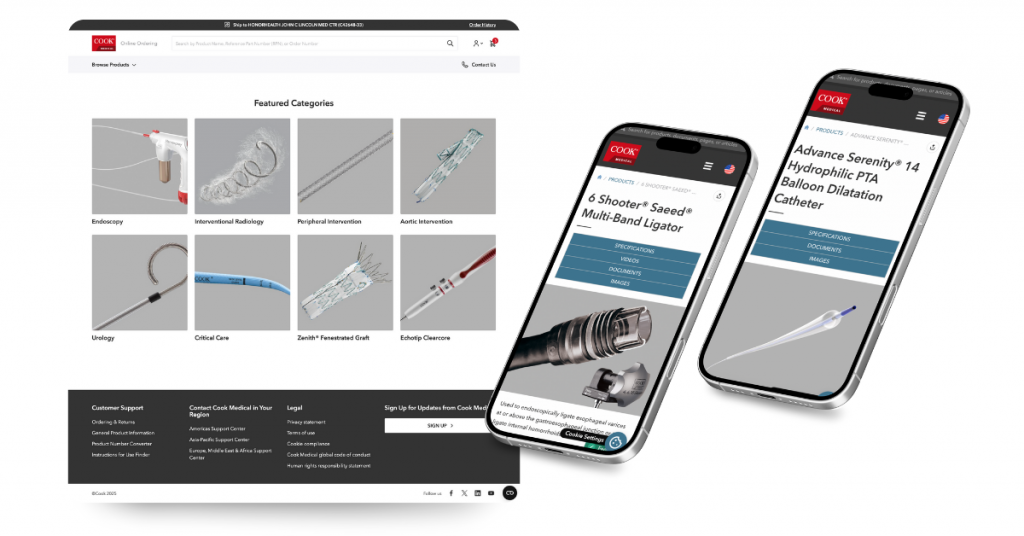
ERP integration
One of the project’s biggest technical requirements was the integration with SnapLogic, Cook Medical’s chosen ERP middleware. At the start of the project, no functional API was in place, and the scope of integration was still evolving. Before development, we stepped in to support planning, helping the client define what data needed to flow, how, and where.
Our team handled:
- Designing a new SnapLogic API to receive order data from Magento 2
- Enabling SnapLogic to use Magento’s REST API to retrieve user, product, and category data
- Building integration logic to support data flow between Magento 2 and SnapLogic in both directions
- Advising on endpoint structure, parameter requirements, and process sequencing.
The only payment integration required was CardConnect, which we configured to align with Cook Medical’s internal payment handling process.
Analytics setup with GA4
Before the migration, Cook Medical had no analytics framework in place. We began by implementing the WeltPixel dataLayer module, configuring it to track key eCommerce events such as product views, add-to-cart actions, checkout progress, and completed purchases. This allowed us to send structured event data to a newly created Google Analytics 4 property via Google Tag Manager (GTM).
To support Cook Medical’s reporting, we extended the default dataLayer with additional product-specific parameters, including:
clinical_specialtiesproduct_typereference_part_numberorder_numbergtin
Other marketing data, such as traffic source, new vs. returning user, average engagement time on the website, approximate visiting location, and tech details such as the browser used for the visit or the device type, are automatically collected by GA4. Ultimately, we consolidated the web behavior & marketing data into one place for better decision-making.
To meet data privacy requirements, we also integrated Cookiebot CMP (Consent Management Platform), allowing users to manage consent preferences while ensuring that tracking scripts only fire after consent is given, which is an essential requirement for global compliance.
Cook Medical now has a robust, compliant, and highly configurable analytics foundation. With GA4 and GTM in place, they have complete visibility into how users interact with the platform, what content drives engagement, areas for improvement, and other insights.
Results
The rebuilt Magento 2 store gives Cook Medical’s internal teams and B2B customers a much clearer and more structured experience. Search performance and product discovery were central to the project’s success. With pricing and availability visible on listing pages and by optimizing navigation for verified users, the site became easier to use and more aligned with how their target buyers place orders.
The new setup is lighter, easier to maintain, and keeps Cook Medical’s digital operations secure and upgrade‑ready.
Customer feedback has been positive, particularly around the improved visibility of key product data. What previously required a manual request or a call can now be completed directly through the interface, without compromising access controls or clinical boundaries.
Project outcomes
- 15,000+ SKUs successfully migrated from Magento 1
- Custom ERP integration delivered and validated via SnapLogic
- Full GA4 analytics implementation with detailed product-level tracking
- Role-based permissions restructured and preserved in Magento 2
- Clean, responsive interface now accessible across devices
- Site launched on schedule over a weekend to avoid disruption, and described by the client as their smoothest launch to date
- Stable, secure, and future‑proofed platform.
Cook Medical has also kicked off a new initiative to integrate Magento 2 with Oracle ERP, expanding the platform’s role in enterprise operations.
Ready to modernize your B2B eCommerce experience? If you’re working with legacy systems or a catalog that demands precision, we’re the team to have by your side. Reach out to scandiweb today, and let’s build a platform that’s functional and easy to use for your team and your customers.
The post Case Study: Dated Magento 1 Migration to a Modern Magento 2 Experience for B2B Buyers appeared first on scandiweb.
]]>The post Inside scandiweb’s CX Audit Workflow for Luxury Fashion Brands appeared first on scandiweb.
]]>Customer experience in luxury eCommerce defines how customers remember the brand. Navigation, layout, language, and even micro-interactions are expressions of the same quality and attention that customers expect from the product itself.
At scandiweb, we treat each CX audit as a structured entry point into long-term growth. Our approach combines expert insight, real customer behavior, and benchmarked data to form a foundation of clarity, mapping the relationship between brand promise and customer journey, and identifying the points where expectation and experience start to drift apart.
This is an immersive process. Rather than applying a standard checklist, we begin our CX audits for luxury and premium brands (as for B2B and B2C brands across an array of other industries) by understanding how the brand defines and presents itself, and then we look for the points in the digital experience that fall short of that definition. That clarity becomes the input for everything that follows, from optimization to redesign to full transformation. Let us elaborate.
A structured discovery for premium CX
When we’re tasked to improve the digital experience of a luxury brand, we treat the first phase as an orientation. The goal is to understand what the brand thinks it’s offering and what the customer is actually experiencing. That gap, often small but critical, is where we usually discover growth.
We approach this orientation through:
- Expert insight to evaluate usability, UX patterns, accessibility, and messaging through the eyes of experienced eCommerce practitioners
- Real customer input via recorded tests with actual brand users, revealing the emotional and behavioral cues that data alone can’t show
- Benchmarking, comparing the brand’s experience against modern UX standards and its direct industry competitors
- Performance data to ground our observations in reality and identify friction in the current customer journey.
We map out what needs to be true for the experience to fully support the brand promise, and then we use that as our direction.
When insight becomes action
Every CX audit produces a long list of insights. But insight without action is just a nice presentation. What transforms our approach into value is how quickly we move from discovery to decision, organizing priorities, scoping fixes, and preparing for implementation.
To do that, we sort findings into three operational layers:
- Quick wins: minor changes that improve experience with minimal effort, often immediately deployable
- UX misalignments: areas where the design doesn’t match user expectations or the brand promise (these are mapped for deeper UX rework or optimization sprints)
- Structural gaps: issues that stem from deeper logic, tech limitations, or architecture, and feed into long-term roadmaps.
By the time the discovery phase concludes, we’ve identified problems and converted them into a structured backlog, organized by impact, effort, and dependency.
What our CX audit looks like in luxury fashion
In a recent CX audit for a premium fashion brand, we conducted a comprehensive experience audit combining user behavior analysis, expert UX review, benchmarking, and direct customer testing. At the end, we produced a roadmap grounded in 130+ distinct recommendations and strategic opportunities. Below are just a few examples of how small experience gaps can have a significant impact.
Homepage insights: structure and scannability
 Unclear key content hierarchy
Unclear key content hierarchy
More than half of homepage users failed to reach the brand’s editorial content or key seasonal campaign messaging. High-intent users dropped off after only scanning the top 1–2 content blocks.
→ We proposed a restructured homepage layout, anchored in clear entry points for new arrivals, style stories, and promotional themes, ensuring better visibility above the fold.
 Banner designs blending with the layout
Banner designs blending with the layout
Hero banners lacked visual separation from adjacent sections, making it difficult for users to recognize when one theme ended and another began.
→ A recommendation was made to introduce subtle visual cues such as whitespace, typography shifts, and scroll indicators to improve orientation without disrupting elegance.
PDP insights: purchase friction in the details
 Fit, fabric, and care info hidden too low
Fit, fabric, and care info hidden too low
Most testers scrolled to find fabric composition and fit guidance after having added items to their cart, often just to confirm.
→ We suggested repositioning these details directly below the price or CTA, framed in a structured quick-specs format to reduce uncertainty and prevent drop-off.
 Color swatch UX causing accidental selections
Color swatch UX causing accidental selections
Users unintentionally changed product variants by interacting with color swatches, expecting them to trigger zoom or detail views.
→ We suggested swatch interactions with hover preview, clear variant change confirmations, and mobile-specific interaction improvements.
 Missing section anchors for long-form content
Missing section anchors for long-form content
High-value items often had extensive product copy but lacked a clear way to navigate it.
→ We recommended collapsible content blocks or anchored tab navigation for smoother scrolling and better readability on desktop and mobile.
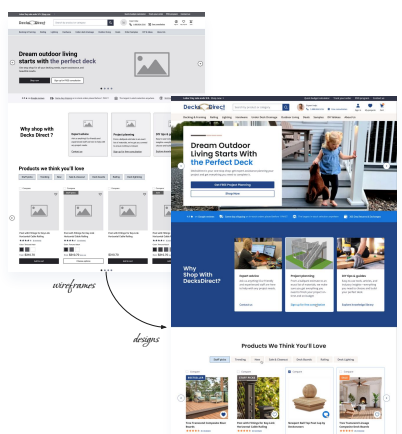
Mobile UX: path to product
 Filters rarely used
Filters rarely used
Mobile filter menus showed a high open rate but very low actual usage. Users found the open/close interaction unintuitive and frequently closed filters before making selections.
→ We proposed a persistent “Filter” chip UI with improved click targets and scroll locking during filter interaction, modeled after top luxury benchmarks.
 New arrivals buried
New arrivals buried
One of the site’s key traffic drivers, new arrivals, was not accessible directly from the homepage or the main navigation on mobile.
→ Added a recommendation to create a mobile-first “Just In” experience with pinned access and adaptive scroll previews.
User testing highlights: behavior patterns
 Promotion banners caused hesitation
Promotion banners caused hesitation
While most testers recognized site-wide promotions (e.g., free shipping thresholds), several ignored them entirely – not because of irrelevance, but due to presentation that felt “non-premium” or “noisy.”
→ Reworking promo language, tone, and integration into the layout was proposed to match the brand’s elevated feel.
 Returns policy anxiety
Returns policy anxiety
On mobile, many testers struggled to find return policy details until late in the journey, often not until the cart or checkout stage.
→ To improve confidence earlier in the journey, we suggested a subtle but visible placement of returns messaging on PDPs and a “Returns” link in the mobile navigation.
Benchmarking insights: what competitors do differently
- Product education – competitors more often used editorial-style modules on PDPs to tell the story behind the product
- Checkout clarity – others offered progress indicators, delivery date estimates, and stronger address input UX
- Brand presence in cart – where most kept branding cues and style strong throughout checkout, our client had a notable drop in visual consistency after the cart.
CX optimization project roadmap
A CX audit is the beginning. Its true value comes from what happens next: turning all of the observations into a manageable roadmap for actual experience improvement.
Clients see an avg. of 30% eCR increase in 12 months with scandiweb’s conversion growth program.

We’ve designed a workflow that translates audit output into prioritized implementation:
- CX audit presentation
Final presentation of the audit to inform future UX/UI updates and optimization roadmap, combining expert review, user testing, data insights, and benchmarking.
- Client feedback loop
The client team reviews findings and shares feedback on specific recommendations to move forward with.
- UX/UI for key pages
Based on confirmed priorities, our designers begin crafting updated wireframes and final designs.
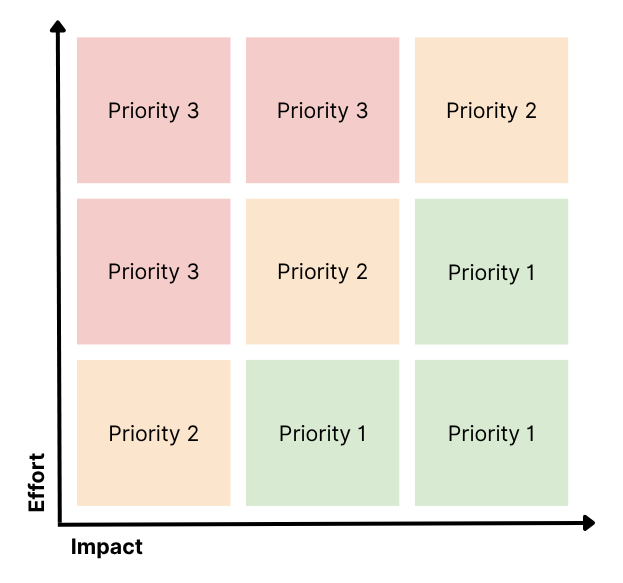
- Conversion growth program
Once redesigns go live, we move into A/B testing, ongoing UX improvements, and CRO-driven iterations. This phase is run by a CRO strategist, but the client gets a full exposure to all scandiweb growth team knowledge and skills to ensure the program is successful. Each sprint concludes with a detailed report outlining the completed tasks and priorities for the next sprint. Through bi-weekly standups, monthly program reports, quarterly roadmap reviews, and ROI reporting, we align on performance. The original CX audit becomes a living roadmap for continued optimization.
Are you ready to see your digital experience through your customers’ eyes and build a roadmap for meaningful change? Reach out to our team to schedule a free individual consultation and develop a growth plan tailored to your business.
The post Inside scandiweb’s CX Audit Workflow for Luxury Fashion Brands appeared first on scandiweb.
]]>The post Agentic Commerce Explained: How ChatGPT Is Changing Online Shopping appeared first on scandiweb.
]]>More shoppers are now turning to ChatGPT to find products. OpenAI’s recent “Buy it in ChatGPT” launch makes chat-based shopping smoother than ever. Customers can search, choose, and pay for products without leaving the conversation. It’s the first real step toward agentic commerce and the next phase of conversational commerce.
Understanding how it works helps eCommerce teams connect their systems to handle new sales coming directly from ChatGPT.
Key takeaways
- Agentic commerce allows customers to buy products directly inside ChatGPT.
- OpenAI launched Instant Checkout with Etsy and plans to expand to Shopify and more platforms.
- Brands on Magento / Adobe Commerce don’t need to replatform to enable this channel, but integration requires a product feed, checkout API, delegated payment flow, and webhooks.
- Early adoption gives merchants visibility in AI-driven product discovery.
What is agentic commerce?

Agentic commerce is the ability to discover and buy products directly inside an AI chat like ChatGPT.
Think of it as an AI shopping assistant that doesn’t just recommend items but completes the purchase for you. The customer stays in the conversation, confirms what they want, and approves payment while the AI securely coordinates the checkout with the merchant’s backend.
Agentic commerce isn’t a scripted dialog that redirects users to a site. It’s a fully functional shopping flow managed by an AI agent following open standards like the Agentic Commerce Protocol (ACP). The merchant still processes the order and handles fulfillment, while ChatGPT acts as the user’s assistant, not a middleman.
“Buy it in ChatGPT” at a glance

OpenAI’s “Buy it in ChatGPT” feature is the first live example of this model. With Instant Checkout, users can find a product and complete payment in the same chat. ChatGPT sends the order directly to the merchant, who fulfills it through their existing systems.
It’s a single, continuous conversation that takes the user from search to purchase.
Also read:
Chat to Buy: The Future of eCommerce Is Conversational
How “Buy it in ChatGPT” works
The Instant Checkout process follows four stages: discovery, checkout session, delegated payment, and fulfillment. Each stage connects ChatGPT to the merchant’s systems through standardized APIs defined in the ACP.

The AI guides the user through product discovery, builds an order via secure API calls, hands off a payment token, and notifies them once the merchant confirms shipment.
Product discovery
ChatGPT starts the journey with a product feed provided by the merchant. The feed includes titles, prices, stock levels, and images, refreshed frequently to stay accurate. ChatGPT uses this feed to show relevant results and only displays a “Buy” button when an item is available and supports Instant Checkout.
In simple terms, the feed replaces the product page: it’s how the AI knows what’s for sale and whether it’s in stock. Keeping that data clean and current ensures every purchase maps to a valid product.
Checkout sessions
When the shopper clicks “Buy” in the chat, ChatGPT sends a secure API request to the merchant’s system to create a new checkout session.
The merchant’s backend (Adobe Commerce, Shopify, etc.) stores the order details like product, quantity, shipping, taxes, and sends back a structured response. ChatGPT uses that response to guide the shopper through the rest of the checkout steps (address, shipping, payment).
Each time the shopper confirms or changes something, ChatGPT sends another request to the same session on your system. And when the shopper approves payment, ChatGPT triggers the complete call, and your system finalizes the order.
If something goes wrong – say an item is out of stock or an address is invalid – ChatGPT shows the message right in the chat, so the user can fix it.
Payments

Payment is handled through delegated payments, not by ChatGPT itself. When the user chooses to pay, ChatGPT generates a Stripe Shared Payment Token (SPT) which is a secure, single-use token that represents the payment method. The token has a limited scope (merchant, amount, expiration) and contains no raw card data, keeping PCI scope minimal.
The merchant’s backend redeems the token via Stripe or another payment service provider to process the charge. While Stripe SPT is the first implementation, other payment service providers are expected to support the same standard. The merchant still reconciles, settles, and refunds directly through their payment system.
Fulfillment and order updates
After payment, the order enters the merchant’s normal fulfillment flow. The merchant sends order webhooks back to OpenAI to keep the chat updated with real-time status: created, confirmed, shipped, or canceled. Each event is signed for verification and retried automatically if delivery fails.
The user can check their order status in ChatGPT, receiving messages like “Your order has shipped” or “Delivery expected tomorrow.” This keeps customers informed after purchase without needing to visit another site or app.
 Quick takeaway
Quick takeaway
ChatGPT acts as the storefront while the merchant’s system handles the transaction. The AI shows available products, creates the order, passes a secure payment token, and updates the buyer once the order ships.
Who can sell via ChatGPT today?

Right now, Instant Checkout is live for U.S.-based Etsy sellers, making their listings available for direct purchase inside ChatGPT. Shopify merchants are next in line, with testing already under way and broader access expected soon.
At launch, Instant Checkout supports single-item purchases only (one product per order) but OpenAI’s roadmap includes multi-item carts, expanded categories, and more regions beyond the U.S. Over time, other platforms and enterprise merchants will be able to join by implementing the open Agentic Commerce Protocol.
 Quick takeaway
Quick takeaway
Instant Checkout is still limited to U.S. merchants, but expansion is coming fast. Brands that clean up product data and build checkout APIs now will be first in line when ChatGPT shopping opens to new regions and platforms.
Why it matters for merchants
Agentic commerce gives brands a new way to sell without changing their existing store setup. It cuts down the steps between interest and purchase. With ChatGPT checkout, a shopper can complete an order the moment they decide to buy.
You stay the merchant of record, running payments, taxes, fulfillment, and support through the systems you already use. There’s no need to move platforms or change providers.
In today’s market, we can’t ignore the fact that shoppers will always choose the easiest option. Making checkout faster and simpler can be the difference between gaining a customer and losing one.
Beyond higher conversions, agentic commerce also means you:
- Keep full control of customer data and post-purchase communication
- Reach new audiences through AI-driven product discovery
- Continue using your existing platform and payment provider
- Gain an early-mover advantage as this new buying model becomes the norm.
 Quick takeaway
Quick takeaway
Agentic commerce pays off over time: faster checkouts, repeat customers, and stronger visibility in AI search. However, success still depends on the basics like having clean data, reliable systems, and clear metrics.
Also read:
Case Study: Conversational Commerce Brings 31% of Churned Customers Back
Integrating agentic commerce with Adobe Commerce/Magento
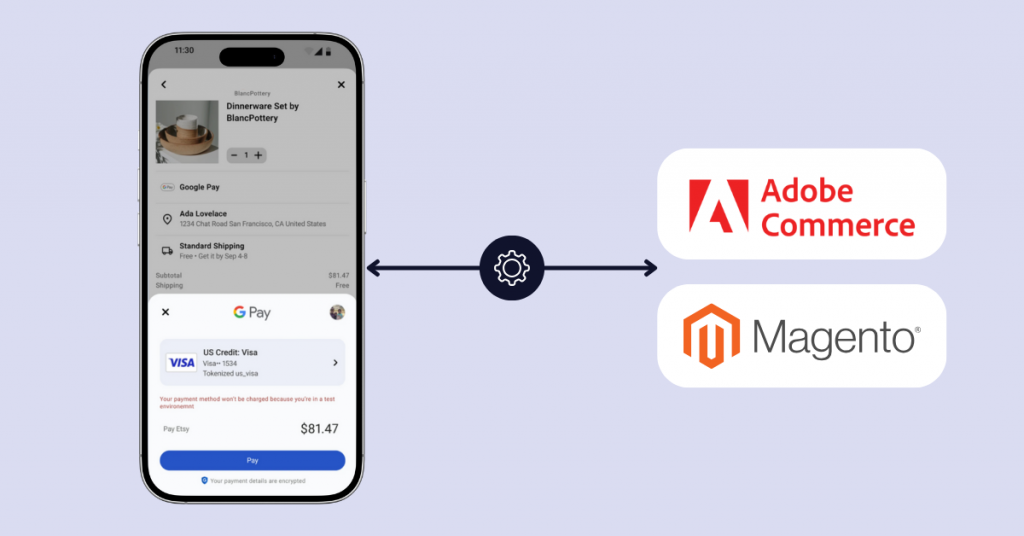
Enterprise merchants on Adobe Commerce (Magento) can enable agentic commerce without replatforming. Magento already has most of what you need – a product catalog, order management, and APIs. The job is to create a few new connections, so ChatGPT can talk to your store using the Agentic Commerce Protocol.
Here’s what needs to be in place:
- A clean, regularly updated product feed that includes product titles, prices, stock levels, and images. This is how ChatGPT knows what’s available to buy.
- A checkout sessions API that allows ChatGPT to create, update, and complete orders, validating addresses and shipping options while avoiding duplicate orders.
- A payment module that supports secure, one-time payment tokens (like the Stripe Shared Payment Token) so charges happen safely without exposing card data.
- Order webhooks that send real-time updates back to ChatGPT when an order is created, shipped, or canceled, with automatic retries for reliability.
- Monitoring and logging to track API errors, webhook delivery, and system performance, alerting your team if something slows or fails.
You’ll need a small team to make it happen: a backend developer to build the APIs, a payments engineer to handle the delegated payment flow, DevOps to manage performance and monitoring, a security lead to review PCI compliance, and QA to test everything in a sandbox before launch.
All of this happens in the backend. Once live, these updates connect your Magento store directly to ChatGPT, allowing shoppers to discover and buy your products inside the chat.
Also read:
Top 16 AI Agent Development Companies in 2025
Security, PCI, and fraud
Handling payments through ChatGPT introduces a new connection between systems, so security needs clear attention from the start.
Tokenization keeps card details out of Magento. ChatGPT never stores or sends raw card numbers. Instead, it uses a Stripe Shared Payment Token which is a single-use code linked to a specific merchant, amount, and expiration. Magento’s existing Stripe integration redeems this token to process the payment, meaning sensitive data never passes through your servers.
To strengthen security even further:
- Turn on 3D Secure (3DS) or Strong Customer Authentication (SCA) where regulations require it
- Keep your payment provider’s fraud checks active: address verification, velocity limits, and risk scoring still apply
- Log API calls and webhook events with sensitive details masked so you can trace issues without exposing data
- Test everything in a sandbox before launch, including failed sessions, expired tokens, and duplicate transactions.
Costs, timelines, and KPIs
Adding Instant Checkout to Magento or Adobe Commerce doesn’t mean rebuilding your store. The time and cost of integration depend on how much you choose to pilot and how ready your systems are.
A small pilot covering one product line typically takes 4–8 weeks with a backend developer, a payments engineer, and QA. Expanding to your full catalog with monitoring and automated testing may take up to 10–14 weeks.
At the moment only approved white-label merchants can participate in Buy it in ChatGPT. Merchants need to apply and be accepted into the program through OpenAI’s official merchant portal.
Fees are straightforward. OpenAI applies a small per-transaction fee for Instant Checkout, while payment processing continues through your existing provider (like Stripe, Adyen, or Braintree) at their usual rates. There are no extra licenses or platform fees.
Once live, track performance using a few key agentic commerce metrics:
- Conversion rate
- Average order value (AOV): whether chat-based orders are larger or smaller than your site’s average
- Time to checkout
- Incremental revenue: whether sales come from new customers or existing ones
- CAC payback: how quickly you recover acquisition costs through completed sales.
Also monitor operational metrics like API uptime, webhook delivery, and refund speed. Together, these show how well your agentic commerce channel performs and where to focus improvements.
Build your integration vs buy
The choice between building your own integration or using an existing one depends on how quickly you want to launch and how much control you need. Magento’s flexibility allows both.
If your goal is speed, start with an existing agentic commerce Magento module. You can install an open-source ACP extension, connect your product feed, and configure checkout endpoints in a matter of weeks. It’s the fastest way to test Instant Checkout with minimal engineering effort.
If you need control, a custom integration is the better route. Developers can build APIs and webhooks directly into Magento, tailor them to your payment provider and ERP, and optimize for performance, error handling, and logging. This path takes longer but gives you full ownership of architecture and data flow.
If you prefer a turnkey rollout, work with an implementation partner familiar with Magento and ACP like scandiweb. A partner can coordinate between your eCommerce, payments, and operations teams, ensuring delegated payments, feeds, and webhooks all run smoothly.
Also read:
Top AI Agencies in 2025: Who’s Leading AI Strategy & Development
Many merchants take a hybrid approach: launch quickly with a module, then extend it to meet enterprise requirements and brand logic once results justify scaling.
And if your store runs on Hyvä, there’s no conflict. Hyvä handles the frontend; agentic commerce sits entirely on the backend. Your site design, checkout styling, and user experience remain untouched.
 Quick takeaway
Quick takeaway
Whether you build, buy, or partner with an agency, Magento supports all paths, but success comes down to three things: clean data, reliable APIs, and clear ownership.
Risks, limitations, and how to mitigate
Like any new channel, Instant Checkout comes with some constraints. Understanding them early helps teams prevent avoidable downtime and protect the buyer experience.
Single-item checkout
Right now, shoppers can only purchase one product per transaction. Treat it as a pilot opportunity: focus on your bestsellers, curated bundles, or limited collections. Then, use post-purchase messaging or email flows to cross-sell complementary products.
Regional and merchant availability
Instant Checkout is currently limited to U.S. merchants and buyers and is available only to approved white-label merchants. Wider access and regional expansion are expected later, so it’s worth preparing your systems now for localization, taxes, and currency handling.
Catalog accuracy
Out-of-date stock or incorrect prices will cause failed orders. Automate product feed refreshes every 10–15 minutes and validate stock during each checkout session. A clean, accurate feed is the single best defense against order errors.
Error handling
Delays or missing data can break the checkout flow. Build your integration so it can safely retry the same request without creating duplicate orders, and make sure any error messages are clear enough for ChatGPT to show the user what went wrong.
API performance and uptime
Fast responses keep checkout smooth. Try to keep your integration’s response time under half a second and monitor it constantly. Set up simple alerts so your team knows right away if requests slow down or fail.
Support and refunds
Some users may message ChatGPT instead of your support team. Include clear order confirmation and contact details in every response, and ensure webhook updates sync with your helpdesk or CRM, so customer service stays consistent.
 Quick takeaway
Quick takeaway
Stay ahead of issues by testing early, monitoring often, and keeping teams in sync. Clean data, clear error handling, and daily checks turn Instant Checkout from a risky pilot into a reliable new sales channel.
Action plan: 7 steps to launch Instant Checkout

A structured rollout keeps the project moving smoothly from idea to live orders. Use these steps to enable Instant Checkout on Magento or Adobe Commerce:
- First, apply for approval from OpenAI. Only accepted white-label merchants can currently participate in Buy it in ChatGPT, so start by submitting your application at chatgpt.com/merchants.
- Choose a product line for the pilot and assign clear owners for backend, payments, QA, and security.
- Make sure you have a clean, accurate product feed with titles, prices, stock, and images, updated every 10–15 minutes.
- Build and test checkout APIs that create, update, and complete orders, including proper validation and error handling.
- Connect your payment provider and set up Stripe Shared Payment Token or another secure token system for delegated payments.
- Send order updates such as created, shipped, and canceled to ChatGPT, and add automatic retries for failed deliveries.
- Run sandbox tests to monitor speed and reliability, then set up alerts for any failed or slow requests.
- Review security, switch to production, brief support, and start tracking performance after go live.
Most teams can complete this in four to eight weeks. Partnering with an experienced Magento and ACP team can speed up delivery, reduce errors, and ensure your integration is ready for scale from day one.
Conclusion
Agentic commerce has already changed how people shop. Joining Instant Checkout keeps your brand visible where customers are already making purchase decisions, while you keep control of payments, orders, and data.
To get started, prepare your agentic commerce checklist, make sure your integrations work correctly, and track early results to see the impact.
Ready to integrate ChatGPT Instant Checkout in your store? scandiweb is the world’s most certified Magento / Adobe Commerce agency with proven experience in AI-driven commerce. Contact us to get a clear, step-by-step roadmap for integrating agentic commerce and turning ChatGPT into a new sales channel for your brand.
Frequently asked questions
Do I need to replatform for agentic commerce?
No. You can enable Instant Checkout on your existing Magento, Shopify, or Salesforce Commerce Cloud store by adding new APIs and a product feed. Your core systems, checkout logic, and payment provider stay the same.
Who owns the customer in ChatGPT checkout?
You do. The merchant remains the merchant of record, owning customer data, payment processing, and fulfillment. ChatGPT only facilitates the conversation and securely passes the order details.
How do refunds and returns work in agentic commerce?
Refunds and returns follow your existing process. The merchant initiates them through their payment provider and updates the user through webhooks or email, just like any other online order.
How do payments work in ChatGPT Instant Checkout?
Payments use delegated tokens issued by your PSP. The customer approves the purchase in ChatGPT; the merchant redeems the token to capture the payment on their existing account.
How long does agentic commerce integration take?
A focused pilot can go live in 4–8 weeks. Most of the effort is backend work: building checkout endpoints, testing delegated payments, and configuring webhooks for order updates.
What’s different for Magento vs Shopify merchants?
Shopify and Etsy merchants are pre-integrated with OpenAI. Magento merchants can join by implementing the open Agentic Commerce Protocol. It’s flexible, self-hosted, and works with any PSP.
How do order webhooks work in agentic checkout?
Webhooks send order status updates (created, shipped, canceled) from your system to ChatGPT. They keep the user informed in real time and mirror your standard OMS or ERP events.
Will agentic commerce cannibalize my site traffic?
Unlikely. Agentic commerce creates a new purchase path for customers who already use AI to shop. It complements your store and adds incremental conversions, not competition.
How does ChatGPT handle taxes and shipping?
Your system calculates both. ChatGPT passes the address; your checkout session returns tax and shipping totals so the customer sees accurate costs before confirming.
Can I customize the checkout flow?
Yes. You control available shipping options, payment methods, and order rules. ChatGPT simply reflects what your API provides.
What happens if an API call fails during checkout?
ChatGPT displays the error message returned by your endpoint, and the user can retry. Use idempotent requests and detailed error codes to ensure clean recovery.
The post Agentic Commerce Explained: How ChatGPT Is Changing Online Shopping appeared first on scandiweb.
]]>The post These Ad Banners Are AI-Generated, but the Clicks Are Real appeared first on scandiweb.
]]>The demand for ad creatives has never been higher, and neither has the pressure to produce them faster. Whether running 5 campaigns or 50 at your company, you’re probably asking a similar question to everyone else right now:
How are we going to complete all these visuals on time?
Creative production has traditionally been a bottleneck (especially with Black Friday or any sales season approaching), requiring styled photoshoots, stock image hunting, endless design rounds, and so on. With generative AI, there’s now a better way to approach this.
At scandiweb, we’ve trained and tested various AI tools to create high-performing visuals for ads. In fact, we produced over 100 high-performing ad creatives for different clients in just two weeks. Let’s explore how to use AI to your advantage – we’ll showcase real examples, share performance insights, and give you a blueprint to speed up creative production.
Sneak peek:)



Key takeaways
- AI ad creatives can match and often outperform traditional production, without the need for photoshoots, product shoots, stock images, or lengthy design timelines.
- What separates effective AI ads from the noise is clarity of intent.
- AI ads benefit from rapid testing and iteration.
- In real campaigns, AI creatives delivered high CTRs and low CPCs, proving their value across industries and formats.
The problem: always waiting on visuals
As digital ad platforms change and competition intensifies, brands are expected to appear everywhere, all the time. Traditional creative production can’t keep up. Producing a single set of high-quality visuals typically involves:
- Product photography or styled shoots
- Creative briefings and revisions
- Copy and design iterations
- Format adjustments for multiple channels.
Multiply that by every target audience, product line, message variant, and platform format, and suddenly your one campaign needs dozens of ad assets just to launch. That can result in:
 Delays in launching campaigns because assets aren’t ready
Delays in launching campaigns because assets aren’t ready Missed testing opportunities, limiting performance insights
Missed testing opportunities, limiting performance insights Creative fatigue, with reused or generic visuals
Creative fatigue, with reused or generic visuals Lower ROAS, simply due to visual underperformance.
Lower ROAS, simply due to visual underperformance.
Your media spend is only as strong as the creatives behind it. Luckily, there’s now a faster, smarter way to deliver them.
The solution: AI-generated ad creatives
Integrating AI into the ad production workflow allows for keeping up with any campaign schedules. Using tools like MidJourney, Runway, Veo3, ChatGPT, and Flora, our Paid Media team has built entire campaign asset libraries from scratch. No product photos and styled shoots needed for any of our clients.
Lifestyle banners, background visuals for motion ads, demos, side-by-side comparisons, or new assets to test messaging variations – with the right approach, you can have full control over the output.
When to use AI for ad creatives
Use AI-generated ad creatives when:
- You need to launch quickly without waiting on styled shoots or internal design resources
- You want to test multiple messaging angles (value-based, product-first, social proof, etc.)
- You’re running seasonal or short-term campaigns
- You want creative diversity
- You’re scaling to various platforms and audiences.
AI is ideal for creating all kinds of ads, including lifestyle visuals that place the product in a real-life context, demo-style images and UI overlays, social proof formats (reviews, ratings, testimonials), background visuals and motion graphics, and conceptual or metaphorical visuals that draw attention.
That said, AI isn’t a fit for every use case. Highly regulated industries or products that require precise accuracy might still need human-led design. But for the majority of brands, proper use of AI offers an advantage that’s hard to ignore.
AI in your campaign workflow
Here’s how a modern, AI-powered creative workflow might look:
- Define the campaign goal – are you building awareness or converting repeat customers? This determines the creative type.
- Generate visual concepts with AI tools – use text-to-image prompts, product references, or overlays to create a variety of visuals.
- Test multiple variants – launch with 2–3 creative directions across platforms. Focus on A/B testing hooks, imagery, and formats.
- Refine based on data – double down on what’s working, then re-generate and adjust.
- Once you find a winning format, replicate it.
The faster you create, the more you can refine and witness performance start to build. This process would otherwise take weeks, but it’s significantly faster when assisted by AI. It’s particularly powerful when paired with high-volume campaign calendars, such as Black Friday, back-to-school sales, spring launches, or other seasonal sales campaigns.
Take a look at some of the stand-outs from our AI Creative Library!






How to make AI creatives that work
You have to remember users are currently hit with AI-generated content from every direction. Ads that work won’t be flashy but thoughtful. Realism plus subtle creative flair will build trust where gimmicks won’t. Think cool transitions and unexpected metaphors to catch attention.
AI can generate anything. That’s the problem and the opportunity. Before you start prompting, ask “what’s the ad supposed to do?” Build trust? Educate, inspire action, show the product in real life? Reassure a skeptical buyer? The goal dictates the style and format of the creative.
Here’s how to make sure your AI-powered ads actually convert.
Focus on user-led storytelling
One of the most effective creative angles right now? Show, don’t tell.
- Use AI to simulate UGC-style visuals, product-in-use scenarios, or day-in-the-life settings
- Emphasize the real-world benefit, not just the product
- Add elements like quotes, testimonials, or messaging overlays that anchor the creative in relatability
- Even if the visuals are not real, they should feel grounded in everyday life.
Add a visual twist
AI excels at creating subtle surrealism, but use that power strategically to catch attention without confusing the viewer:
- A background that moves while the product remains still
- A visual metaphor that conveys a product benefit
- A juxtaposition of two ideas (e.g., natural ingredients + clinical effectiveness).
If something looks too fake or too AI, it won’t convert. Shoppers are savvy, so you should still prioritize realistic lighting and proportions, avoid overly stylized or uncanny imagery, use reference images for consistency and brand alignment, and blend AI visuals with human-written copy and proven ad formats.
A/B test fast and often
Because AI allows you to generate multiple versions in hours, not days, you can quickly test different product angles, color tones, background context, emotional vs. rational creative tone, etc. Use performance data to refine your prompts.
AI can create high-quality, on-brand visuals tailored to the campaign goal super fast. What’s more, our testing proves they work. Let us show you!
Case studies: AI ad creatives in action
Trust-building creatives for pet products

AI model: ChatGPT image generation with product reference
Goal: Build trust and conversions through social proof, tailored for pet owners
- Impressions: 15,312
- Click-through rate: 0.63%
- Return on ad spend: 10.55
Why it worked: realistic, relatable imagery paired with a genuine-sounding customer review hits home with pet owners, especially those dealing with sensitive digestion issues.

AI model: Runway
Goal: Educate and convert by visualizing high-quality ingredients
- Impressions: 39,686
- CTR: 0.50%
- ROAS: 9.50
Why it worked: ingredient awareness is a key driver for health-conscious shoppers; the visuals convey freshness and quality without needing photography.
Credibility in ads for a wellness brand

AI model: Flora GPT, Sora, Midjourney
Goal: Encourage action by showcasing consultation with Swiss doctors
- Reach: 160,158
- CPC: 3.14 CHF
- CPM: 1.61 CHF
Why it worked: emphasizing credibility helps move users from awareness to action, while visual realism plus healthcare-centric messaging builds trust.

AI model: Flora GPT, Midjourney, Runway
Goal: Inspire confidence and conversions for MS symptom management services
- Reach: 202,395
- CPC: 3.20 CHF
- CPM: 1.67 CHF
Why it worked: a blend of hopeful messaging and empowering visuals, conveying discretion, ease-of-use, and professionalism.
Video content enriched with AI

Goal: Drive efficient clicks and form submissions at low cost
- CTR: 3.65%
- Link Clicks: 235
- Reach: 4,860
Why it worked: combining real footage with AI-enhanced visual storytelling created credibility while catching attention.

Goal: Capture attention and drive contact signups through a storytelling-led format
- CTR: 3.45%
- Link Clicks: 207
- Reach: 4,786
Why it worked: the animated format created an emotional hook while staying brand-appropriate. It delivered a relatable, human feel, resulting in the highest contact volume of the test group.
So, it’s official, AI has entered the paid media toolkit as a high-performance solution. If properly trained, AI-generated visuals can be on-brand, performance-driven, and scalable across platforms, converting effectively.
We’ve seen firsthand how AI-generated ad creatives:
- Help teams produce campaign assets faster and at higher volume
- Deliver visuals that align with brand and messaging goals, without needing custom photos or stock images
- Enable faster testing cycles, improving creative insights and campaign outcomes
- Perform across different formats – motion graphics, lifestyle ads, review-based visuals, and so much more.
Ready to launch your best-performing ads with ease? Our AI and Paid Media teams have already created hundreds of high-performing creatives for clients across industries, and we’re just getting started. Book a free consultation, and let’s figure out how AI can improve your ads and your broader marketing operations!
The post These Ad Banners Are AI-Generated, but the Clicks Are Real appeared first on scandiweb.
]]>